Primark's Business Environment Analysis
VerifiedAdded on 2020/06/04
|21
|6379
|95
AI Summary
This assignment requires a comprehensive analysis of Primark's business environment. Students must examine Primark's organizational structure using the provided chart, analyze its revenue growth from 2007 to 2016 based on the given data, and assess the various external factors influencing its operations. The analysis should demonstrate an understanding of key business concepts and how they apply to a real-world company like Primark.
Contribute Materials
Your contribution can guide someone’s learning journey. Share your
documents today.
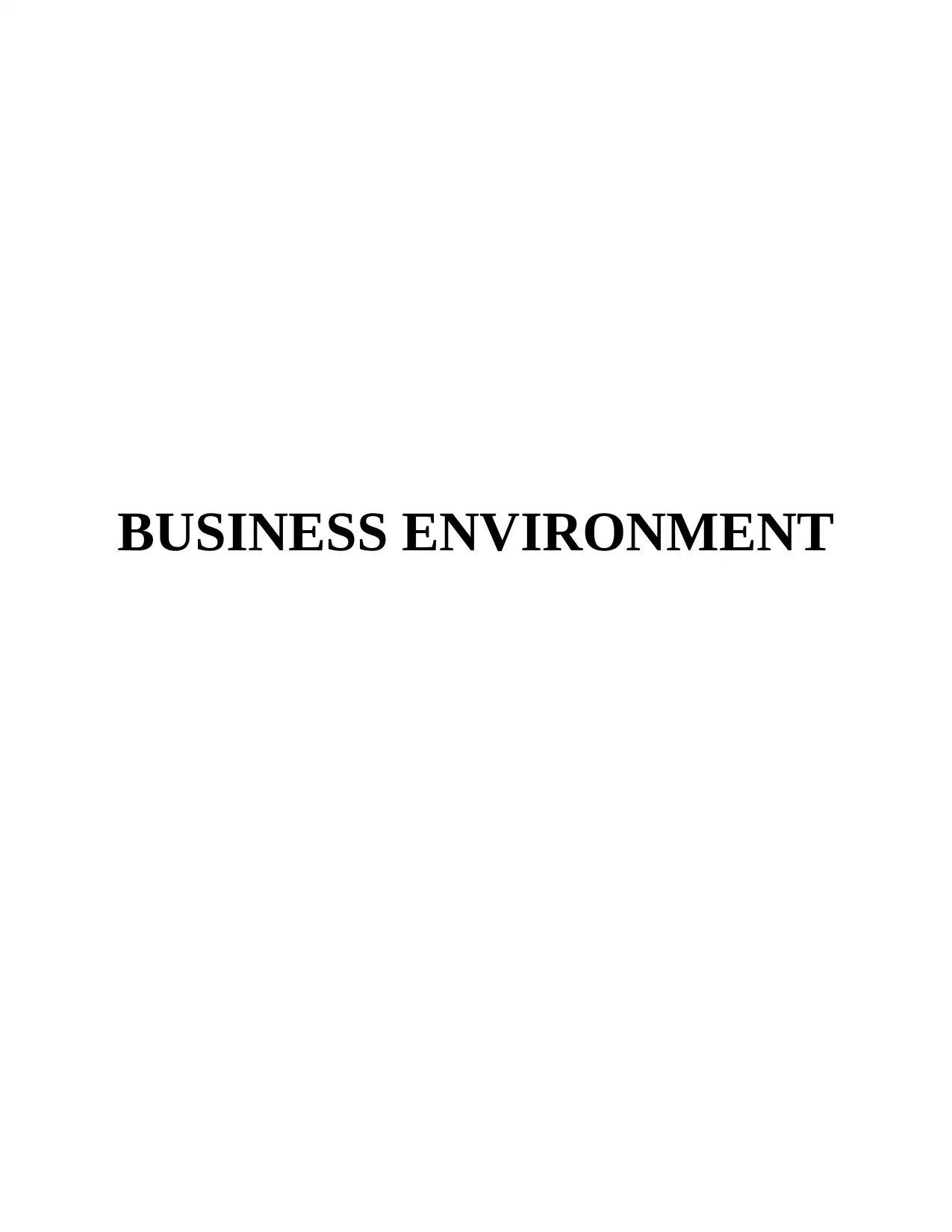
BUSINESS ENVIRONMENT
Secure Best Marks with AI Grader
Need help grading? Try our AI Grader for instant feedback on your assignments.
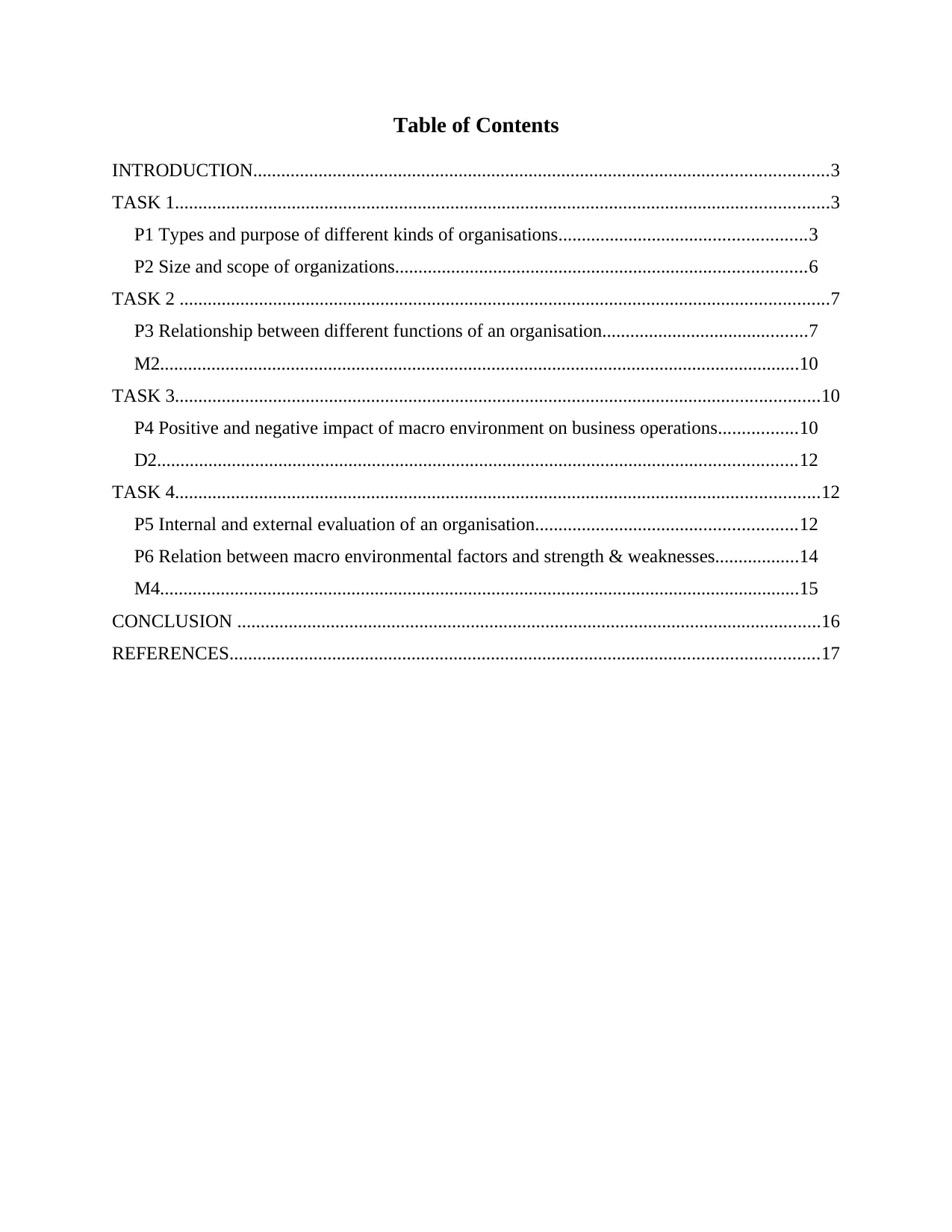
Table of Contents
INTRODUCTION...........................................................................................................................3
TASK 1............................................................................................................................................3
P1 Types and purpose of different kinds of organisations.....................................................3
P2 Size and scope of organizations........................................................................................6
TASK 2 ...........................................................................................................................................7
P3 Relationship between different functions of an organisation............................................7
M2.........................................................................................................................................10
TASK 3..........................................................................................................................................10
P4 Positive and negative impact of macro environment on business operations.................10
D2.........................................................................................................................................12
TASK 4..........................................................................................................................................12
P5 Internal and external evaluation of an organisation........................................................12
P6 Relation between macro environmental factors and strength & weaknesses..................14
M4.........................................................................................................................................15
CONCLUSION .............................................................................................................................16
REFERENCES..............................................................................................................................17
INTRODUCTION...........................................................................................................................3
TASK 1............................................................................................................................................3
P1 Types and purpose of different kinds of organisations.....................................................3
P2 Size and scope of organizations........................................................................................6
TASK 2 ...........................................................................................................................................7
P3 Relationship between different functions of an organisation............................................7
M2.........................................................................................................................................10
TASK 3..........................................................................................................................................10
P4 Positive and negative impact of macro environment on business operations.................10
D2.........................................................................................................................................12
TASK 4..........................................................................................................................................12
P5 Internal and external evaluation of an organisation........................................................12
P6 Relation between macro environmental factors and strength & weaknesses..................14
M4.........................................................................................................................................15
CONCLUSION .............................................................................................................................16
REFERENCES..............................................................................................................................17

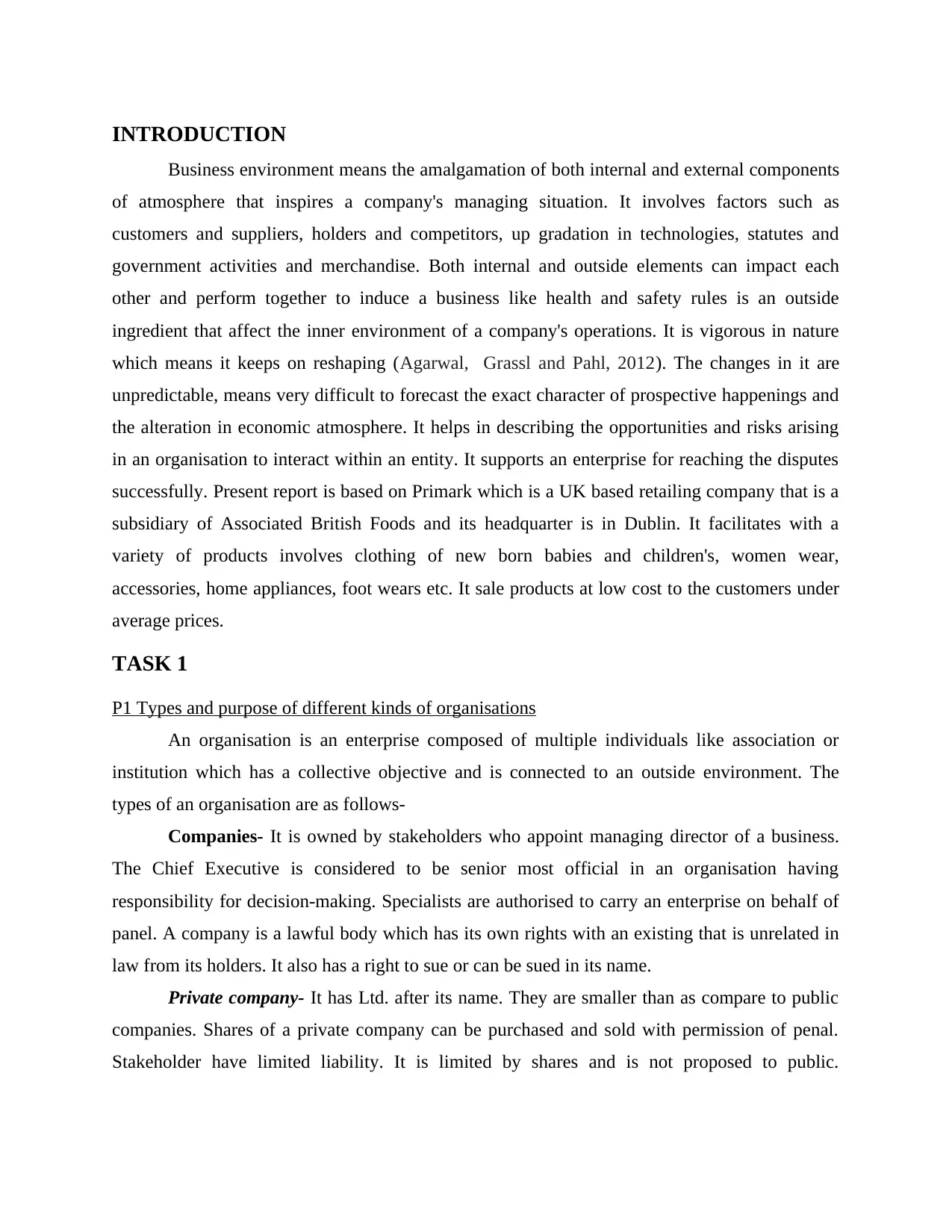
INTRODUCTION
Business environment means the amalgamation of both internal and external components
of atmosphere that inspires a company's managing situation. It involves factors such as
customers and suppliers, holders and competitors, up gradation in technologies, statutes and
government activities and merchandise. Both internal and outside elements can impact each
other and perform together to induce a business like health and safety rules is an outside
ingredient that affect the inner environment of a company's operations. It is vigorous in nature
which means it keeps on reshaping (Agarwal, Grassl and Pahl, 2012). The changes in it are
unpredictable, means very difficult to forecast the exact character of prospective happenings and
the alteration in economic atmosphere. It helps in describing the opportunities and risks arising
in an organisation to interact within an entity. It supports an enterprise for reaching the disputes
successfully. Present report is based on Primark which is a UK based retailing company that is a
subsidiary of Associated British Foods and its headquarter is in Dublin. It facilitates with a
variety of products involves clothing of new born babies and children's, women wear,
accessories, home appliances, foot wears etc. It sale products at low cost to the customers under
average prices.
TASK 1
P1 Types and purpose of different kinds of organisations
An organisation is an enterprise composed of multiple individuals like association or
institution which has a collective objective and is connected to an outside environment. The
types of an organisation are as follows-
Companies- It is owned by stakeholders who appoint managing director of a business.
The Chief Executive is considered to be senior most official in an organisation having
responsibility for decision-making. Specialists are authorised to carry an enterprise on behalf of
panel. A company is a lawful body which has its own rights with an existing that is unrelated in
law from its holders. It also has a right to sue or can be sued in its name.
Private company- It has Ltd. after its name. They are smaller than as compare to public
companies. Shares of a private company can be purchased and sold with permission of penal.
Stakeholder have limited liability. It is limited by shares and is not proposed to public.
Business environment means the amalgamation of both internal and external components
of atmosphere that inspires a company's managing situation. It involves factors such as
customers and suppliers, holders and competitors, up gradation in technologies, statutes and
government activities and merchandise. Both internal and outside elements can impact each
other and perform together to induce a business like health and safety rules is an outside
ingredient that affect the inner environment of a company's operations. It is vigorous in nature
which means it keeps on reshaping (Agarwal, Grassl and Pahl, 2012). The changes in it are
unpredictable, means very difficult to forecast the exact character of prospective happenings and
the alteration in economic atmosphere. It helps in describing the opportunities and risks arising
in an organisation to interact within an entity. It supports an enterprise for reaching the disputes
successfully. Present report is based on Primark which is a UK based retailing company that is a
subsidiary of Associated British Foods and its headquarter is in Dublin. It facilitates with a
variety of products involves clothing of new born babies and children's, women wear,
accessories, home appliances, foot wears etc. It sale products at low cost to the customers under
average prices.
TASK 1
P1 Types and purpose of different kinds of organisations
An organisation is an enterprise composed of multiple individuals like association or
institution which has a collective objective and is connected to an outside environment. The
types of an organisation are as follows-
Companies- It is owned by stakeholders who appoint managing director of a business.
The Chief Executive is considered to be senior most official in an organisation having
responsibility for decision-making. Specialists are authorised to carry an enterprise on behalf of
panel. A company is a lawful body which has its own rights with an existing that is unrelated in
law from its holders. It also has a right to sue or can be sued in its name.
Private company- It has Ltd. after its name. They are smaller than as compare to public
companies. Shares of a private company can be purchased and sold with permission of penal.
Stakeholder have limited liability. It is limited by shares and is not proposed to public.
Secure Best Marks with AI Grader
Need help grading? Try our AI Grader for instant feedback on your assignments.
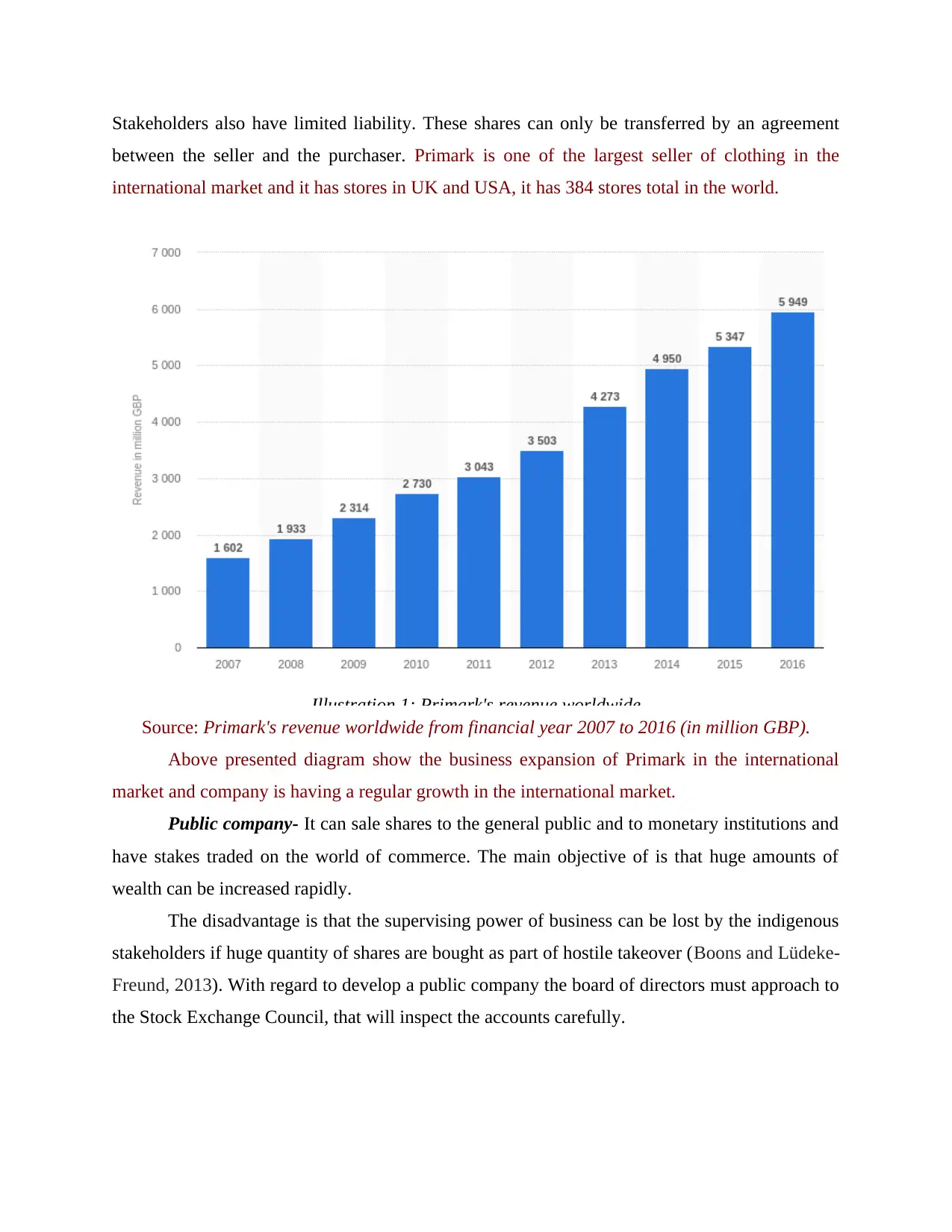
Stakeholders also have limited liability. These shares can only be transferred by an agreement
between the seller and the purchaser. Primark is one of the largest seller of clothing in the
international market and it has stores in UK and USA, it has 384 stores total in the world.
Source: Primark's revenue worldwide from financial year 2007 to 2016 (in million GBP).
Above presented diagram show the business expansion of Primark in the international
market and company is having a regular growth in the international market.
Public company- It can sale shares to the general public and to monetary institutions and
have stakes traded on the world of commerce. The main objective of is that huge amounts of
wealth can be increased rapidly.
The disadvantage is that the supervising power of business can be lost by the indigenous
stakeholders if huge quantity of shares are bought as part of hostile takeover (Boons and Lüdeke-
Freund, 2013). With regard to develop a public company the board of directors must approach to
the Stock Exchange Council, that will inspect the accounts carefully.
Illustration 1: Primark's revenue worldwide
between the seller and the purchaser. Primark is one of the largest seller of clothing in the
international market and it has stores in UK and USA, it has 384 stores total in the world.
Source: Primark's revenue worldwide from financial year 2007 to 2016 (in million GBP).
Above presented diagram show the business expansion of Primark in the international
market and company is having a regular growth in the international market.
Public company- It can sale shares to the general public and to monetary institutions and
have stakes traded on the world of commerce. The main objective of is that huge amounts of
wealth can be increased rapidly.
The disadvantage is that the supervising power of business can be lost by the indigenous
stakeholders if huge quantity of shares are bought as part of hostile takeover (Boons and Lüdeke-
Freund, 2013). With regard to develop a public company the board of directors must approach to
the Stock Exchange Council, that will inspect the accounts carefully.
Illustration 1: Primark's revenue worldwide
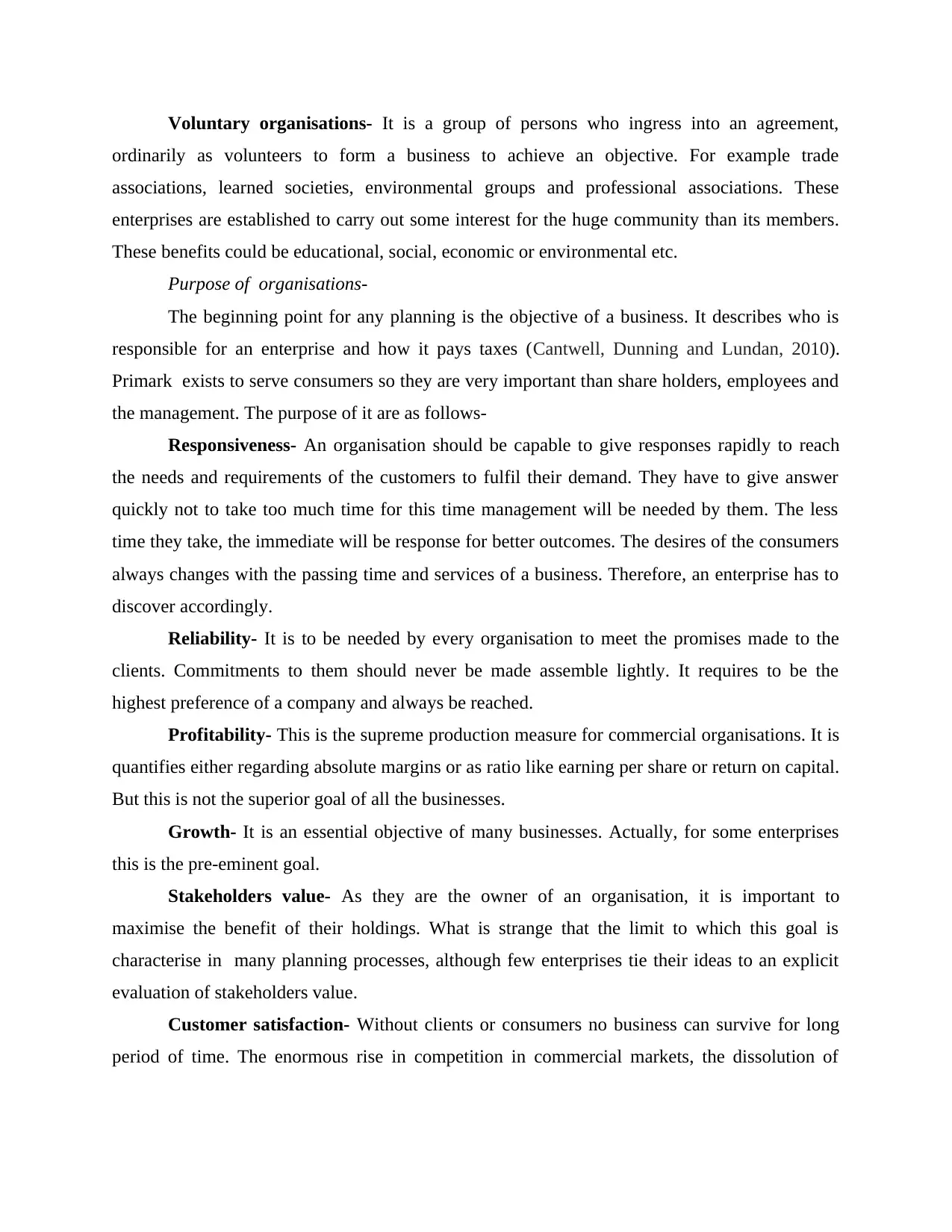
Voluntary organisations- It is a group of persons who ingress into an agreement,
ordinarily as volunteers to form a business to achieve an objective. For example trade
associations, learned societies, environmental groups and professional associations. These
enterprises are established to carry out some interest for the huge community than its members.
These benefits could be educational, social, economic or environmental etc.
Purpose of organisations-
The beginning point for any planning is the objective of a business. It describes who is
responsible for an enterprise and how it pays taxes (Cantwell, Dunning and Lundan, 2010).
Primark exists to serve consumers so they are very important than share holders, employees and
the management. The purpose of it are as follows-
Responsiveness- An organisation should be capable to give responses rapidly to reach
the needs and requirements of the customers to fulfil their demand. They have to give answer
quickly not to take too much time for this time management will be needed by them. The less
time they take, the immediate will be response for better outcomes. The desires of the consumers
always changes with the passing time and services of a business. Therefore, an enterprise has to
discover accordingly.
Reliability- It is to be needed by every organisation to meet the promises made to the
clients. Commitments to them should never be made assemble lightly. It requires to be the
highest preference of a company and always be reached.
Profitability- This is the supreme production measure for commercial organisations. It is
quantifies either regarding absolute margins or as ratio like earning per share or return on capital.
But this is not the superior goal of all the businesses.
Growth- It is an essential objective of many businesses. Actually, for some enterprises
this is the pre-eminent goal.
Stakeholders value- As they are the owner of an organisation, it is important to
maximise the benefit of their holdings. What is strange that the limit to which this goal is
characterise in many planning processes, although few enterprises tie their ideas to an explicit
evaluation of stakeholders value.
Customer satisfaction- Without clients or consumers no business can survive for long
period of time. The enormous rise in competition in commercial markets, the dissolution of
ordinarily as volunteers to form a business to achieve an objective. For example trade
associations, learned societies, environmental groups and professional associations. These
enterprises are established to carry out some interest for the huge community than its members.
These benefits could be educational, social, economic or environmental etc.
Purpose of organisations-
The beginning point for any planning is the objective of a business. It describes who is
responsible for an enterprise and how it pays taxes (Cantwell, Dunning and Lundan, 2010).
Primark exists to serve consumers so they are very important than share holders, employees and
the management. The purpose of it are as follows-
Responsiveness- An organisation should be capable to give responses rapidly to reach
the needs and requirements of the customers to fulfil their demand. They have to give answer
quickly not to take too much time for this time management will be needed by them. The less
time they take, the immediate will be response for better outcomes. The desires of the consumers
always changes with the passing time and services of a business. Therefore, an enterprise has to
discover accordingly.
Reliability- It is to be needed by every organisation to meet the promises made to the
clients. Commitments to them should never be made assemble lightly. It requires to be the
highest preference of a company and always be reached.
Profitability- This is the supreme production measure for commercial organisations. It is
quantifies either regarding absolute margins or as ratio like earning per share or return on capital.
But this is not the superior goal of all the businesses.
Growth- It is an essential objective of many businesses. Actually, for some enterprises
this is the pre-eminent goal.
Stakeholders value- As they are the owner of an organisation, it is important to
maximise the benefit of their holdings. What is strange that the limit to which this goal is
characterise in many planning processes, although few enterprises tie their ideas to an explicit
evaluation of stakeholders value.
Customer satisfaction- Without clients or consumers no business can survive for long
period of time. The enormous rise in competition in commercial markets, the dissolution of
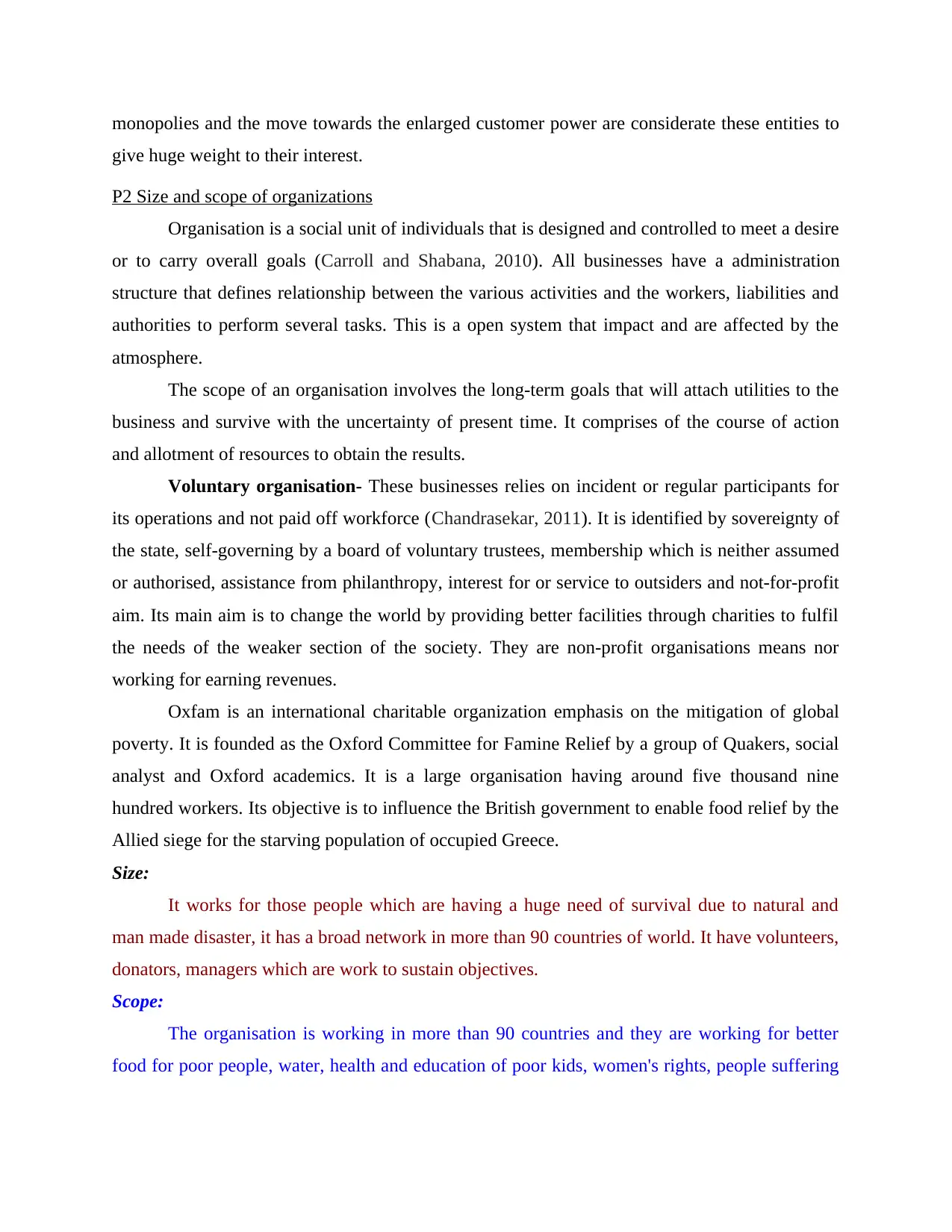
monopolies and the move towards the enlarged customer power are considerate these entities to
give huge weight to their interest.
P2 Size and scope of organizations
Organisation is a social unit of individuals that is designed and controlled to meet a desire
or to carry overall goals (Carroll and Shabana, 2010). All businesses have a administration
structure that defines relationship between the various activities and the workers, liabilities and
authorities to perform several tasks. This is a open system that impact and are affected by the
atmosphere.
The scope of an organisation involves the long-term goals that will attach utilities to the
business and survive with the uncertainty of present time. It comprises of the course of action
and allotment of resources to obtain the results.
Voluntary organisation- These businesses relies on incident or regular participants for
its operations and not paid off workforce (Chandrasekar, 2011). It is identified by sovereignty of
the state, self-governing by a board of voluntary trustees, membership which is neither assumed
or authorised, assistance from philanthropy, interest for or service to outsiders and not-for-profit
aim. Its main aim is to change the world by providing better facilities through charities to fulfil
the needs of the weaker section of the society. They are non-profit organisations means nor
working for earning revenues.
Oxfam is an international charitable organization emphasis on the mitigation of global
poverty. It is founded as the Oxford Committee for Famine Relief by a group of Quakers, social
analyst and Oxford academics. It is a large organisation having around five thousand nine
hundred workers. Its objective is to influence the British government to enable food relief by the
Allied siege for the starving population of occupied Greece.
Size:
It works for those people which are having a huge need of survival due to natural and
man made disaster, it has a broad network in more than 90 countries of world. It have volunteers,
donators, managers which are work to sustain objectives.
Scope:
The organisation is working in more than 90 countries and they are working for better
food for poor people, water, health and education of poor kids, women's rights, people suffering
give huge weight to their interest.
P2 Size and scope of organizations
Organisation is a social unit of individuals that is designed and controlled to meet a desire
or to carry overall goals (Carroll and Shabana, 2010). All businesses have a administration
structure that defines relationship between the various activities and the workers, liabilities and
authorities to perform several tasks. This is a open system that impact and are affected by the
atmosphere.
The scope of an organisation involves the long-term goals that will attach utilities to the
business and survive with the uncertainty of present time. It comprises of the course of action
and allotment of resources to obtain the results.
Voluntary organisation- These businesses relies on incident or regular participants for
its operations and not paid off workforce (Chandrasekar, 2011). It is identified by sovereignty of
the state, self-governing by a board of voluntary trustees, membership which is neither assumed
or authorised, assistance from philanthropy, interest for or service to outsiders and not-for-profit
aim. Its main aim is to change the world by providing better facilities through charities to fulfil
the needs of the weaker section of the society. They are non-profit organisations means nor
working for earning revenues.
Oxfam is an international charitable organization emphasis on the mitigation of global
poverty. It is founded as the Oxford Committee for Famine Relief by a group of Quakers, social
analyst and Oxford academics. It is a large organisation having around five thousand nine
hundred workers. Its objective is to influence the British government to enable food relief by the
Allied siege for the starving population of occupied Greece.
Size:
It works for those people which are having a huge need of survival due to natural and
man made disaster, it has a broad network in more than 90 countries of world. It have volunteers,
donators, managers which are work to sustain objectives.
Scope:
The organisation is working in more than 90 countries and they are working for better
food for poor people, water, health and education of poor kids, women's rights, people suffering
Paraphrase This Document
Need a fresh take? Get an instant paraphrase of this document with our AI Paraphraser
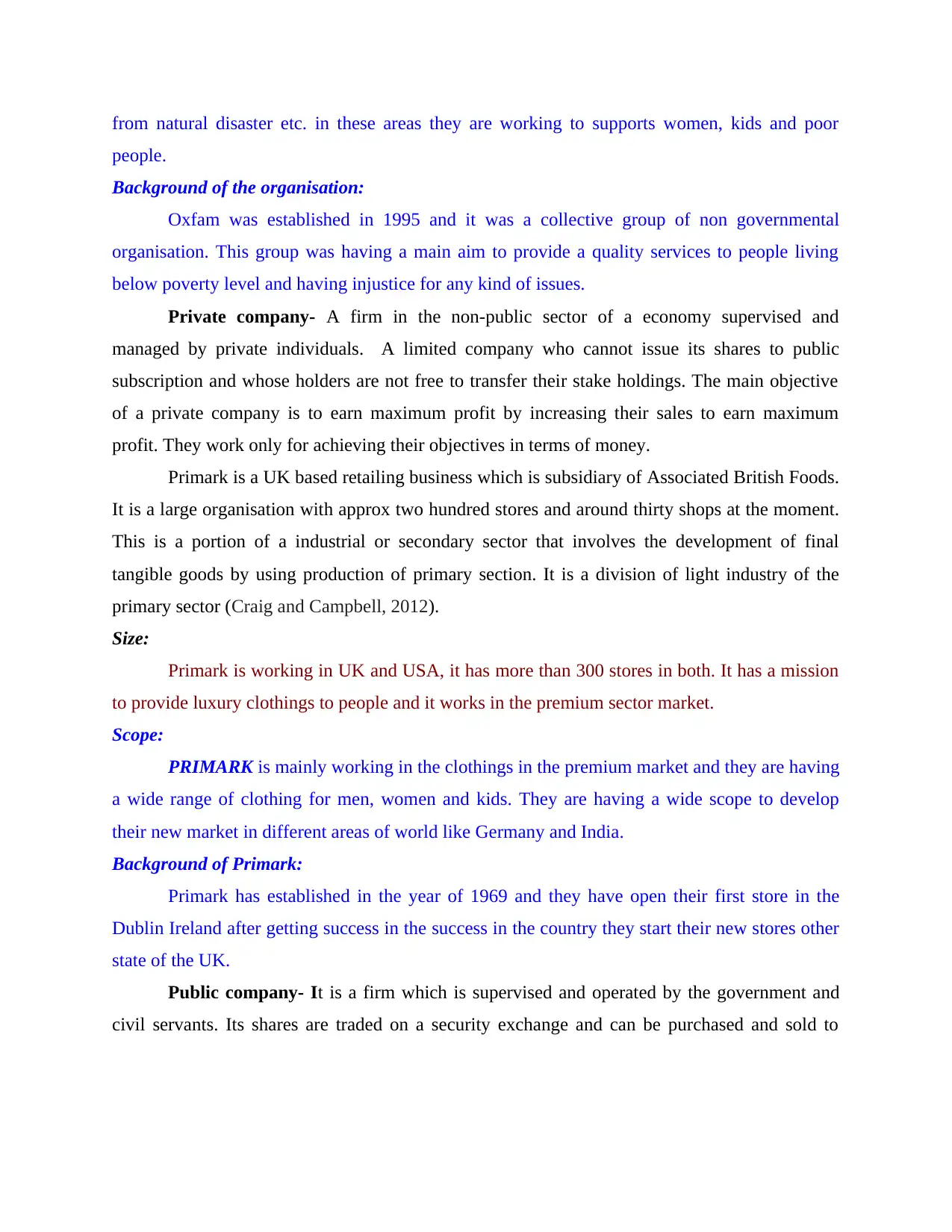
from natural disaster etc. in these areas they are working to supports women, kids and poor
people.
Background of the organisation:
Oxfam was established in 1995 and it was a collective group of non governmental
organisation. This group was having a main aim to provide a quality services to people living
below poverty level and having injustice for any kind of issues.
Private company- A firm in the non-public sector of a economy supervised and
managed by private individuals. A limited company who cannot issue its shares to public
subscription and whose holders are not free to transfer their stake holdings. The main objective
of a private company is to earn maximum profit by increasing their sales to earn maximum
profit. They work only for achieving their objectives in terms of money.
Primark is a UK based retailing business which is subsidiary of Associated British Foods.
It is a large organisation with approx two hundred stores and around thirty shops at the moment.
This is a portion of a industrial or secondary sector that involves the development of final
tangible goods by using production of primary section. It is a division of light industry of the
primary sector (Craig and Campbell, 2012).
Size:
Primark is working in UK and USA, it has more than 300 stores in both. It has a mission
to provide luxury clothings to people and it works in the premium sector market.
Scope:
PRIMARK is mainly working in the clothings in the premium market and they are having
a wide range of clothing for men, women and kids. They are having a wide scope to develop
their new market in different areas of world like Germany and India.
Background of Primark:
Primark has established in the year of 1969 and they have open their first store in the
Dublin Ireland after getting success in the success in the country they start their new stores other
state of the UK.
Public company- It is a firm which is supervised and operated by the government and
civil servants. Its shares are traded on a security exchange and can be purchased and sold to
people.
Background of the organisation:
Oxfam was established in 1995 and it was a collective group of non governmental
organisation. This group was having a main aim to provide a quality services to people living
below poverty level and having injustice for any kind of issues.
Private company- A firm in the non-public sector of a economy supervised and
managed by private individuals. A limited company who cannot issue its shares to public
subscription and whose holders are not free to transfer their stake holdings. The main objective
of a private company is to earn maximum profit by increasing their sales to earn maximum
profit. They work only for achieving their objectives in terms of money.
Primark is a UK based retailing business which is subsidiary of Associated British Foods.
It is a large organisation with approx two hundred stores and around thirty shops at the moment.
This is a portion of a industrial or secondary sector that involves the development of final
tangible goods by using production of primary section. It is a division of light industry of the
primary sector (Craig and Campbell, 2012).
Size:
Primark is working in UK and USA, it has more than 300 stores in both. It has a mission
to provide luxury clothings to people and it works in the premium sector market.
Scope:
PRIMARK is mainly working in the clothings in the premium market and they are having
a wide range of clothing for men, women and kids. They are having a wide scope to develop
their new market in different areas of world like Germany and India.
Background of Primark:
Primark has established in the year of 1969 and they have open their first store in the
Dublin Ireland after getting success in the success in the country they start their new stores other
state of the UK.
Public company- It is a firm which is supervised and operated by the government and
civil servants. Its shares are traded on a security exchange and can be purchased and sold to
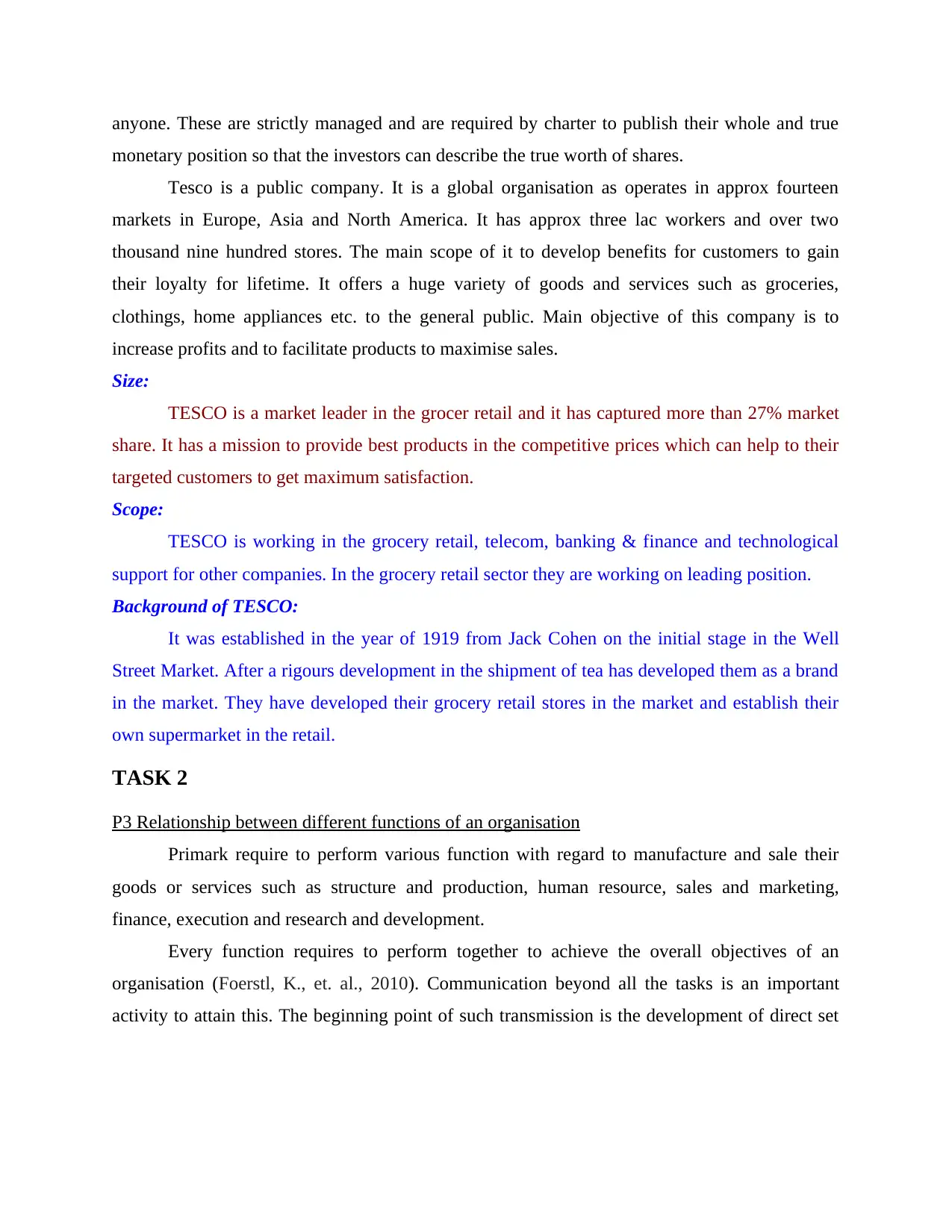
anyone. These are strictly managed and are required by charter to publish their whole and true
monetary position so that the investors can describe the true worth of shares.
Tesco is a public company. It is a global organisation as operates in approx fourteen
markets in Europe, Asia and North America. It has approx three lac workers and over two
thousand nine hundred stores. The main scope of it to develop benefits for customers to gain
their loyalty for lifetime. It offers a huge variety of goods and services such as groceries,
clothings, home appliances etc. to the general public. Main objective of this company is to
increase profits and to facilitate products to maximise sales.
Size:
TESCO is a market leader in the grocer retail and it has captured more than 27% market
share. It has a mission to provide best products in the competitive prices which can help to their
targeted customers to get maximum satisfaction.
Scope:
TESCO is working in the grocery retail, telecom, banking & finance and technological
support for other companies. In the grocery retail sector they are working on leading position.
Background of TESCO:
It was established in the year of 1919 from Jack Cohen on the initial stage in the Well
Street Market. After a rigours development in the shipment of tea has developed them as a brand
in the market. They have developed their grocery retail stores in the market and establish their
own supermarket in the retail.
TASK 2
P3 Relationship between different functions of an organisation
Primark require to perform various function with regard to manufacture and sale their
goods or services such as structure and production, human resource, sales and marketing,
finance, execution and research and development.
Every function requires to perform together to achieve the overall objectives of an
organisation (Foerstl, K., et. al., 2010). Communication beyond all the tasks is an important
activity to attain this. The beginning point of such transmission is the development of direct set
monetary position so that the investors can describe the true worth of shares.
Tesco is a public company. It is a global organisation as operates in approx fourteen
markets in Europe, Asia and North America. It has approx three lac workers and over two
thousand nine hundred stores. The main scope of it to develop benefits for customers to gain
their loyalty for lifetime. It offers a huge variety of goods and services such as groceries,
clothings, home appliances etc. to the general public. Main objective of this company is to
increase profits and to facilitate products to maximise sales.
Size:
TESCO is a market leader in the grocer retail and it has captured more than 27% market
share. It has a mission to provide best products in the competitive prices which can help to their
targeted customers to get maximum satisfaction.
Scope:
TESCO is working in the grocery retail, telecom, banking & finance and technological
support for other companies. In the grocery retail sector they are working on leading position.
Background of TESCO:
It was established in the year of 1919 from Jack Cohen on the initial stage in the Well
Street Market. After a rigours development in the shipment of tea has developed them as a brand
in the market. They have developed their grocery retail stores in the market and establish their
own supermarket in the retail.
TASK 2
P3 Relationship between different functions of an organisation
Primark require to perform various function with regard to manufacture and sale their
goods or services such as structure and production, human resource, sales and marketing,
finance, execution and research and development.
Every function requires to perform together to achieve the overall objectives of an
organisation (Foerstl, K., et. al., 2010). Communication beyond all the tasks is an important
activity to attain this. The beginning point of such transmission is the development of direct set
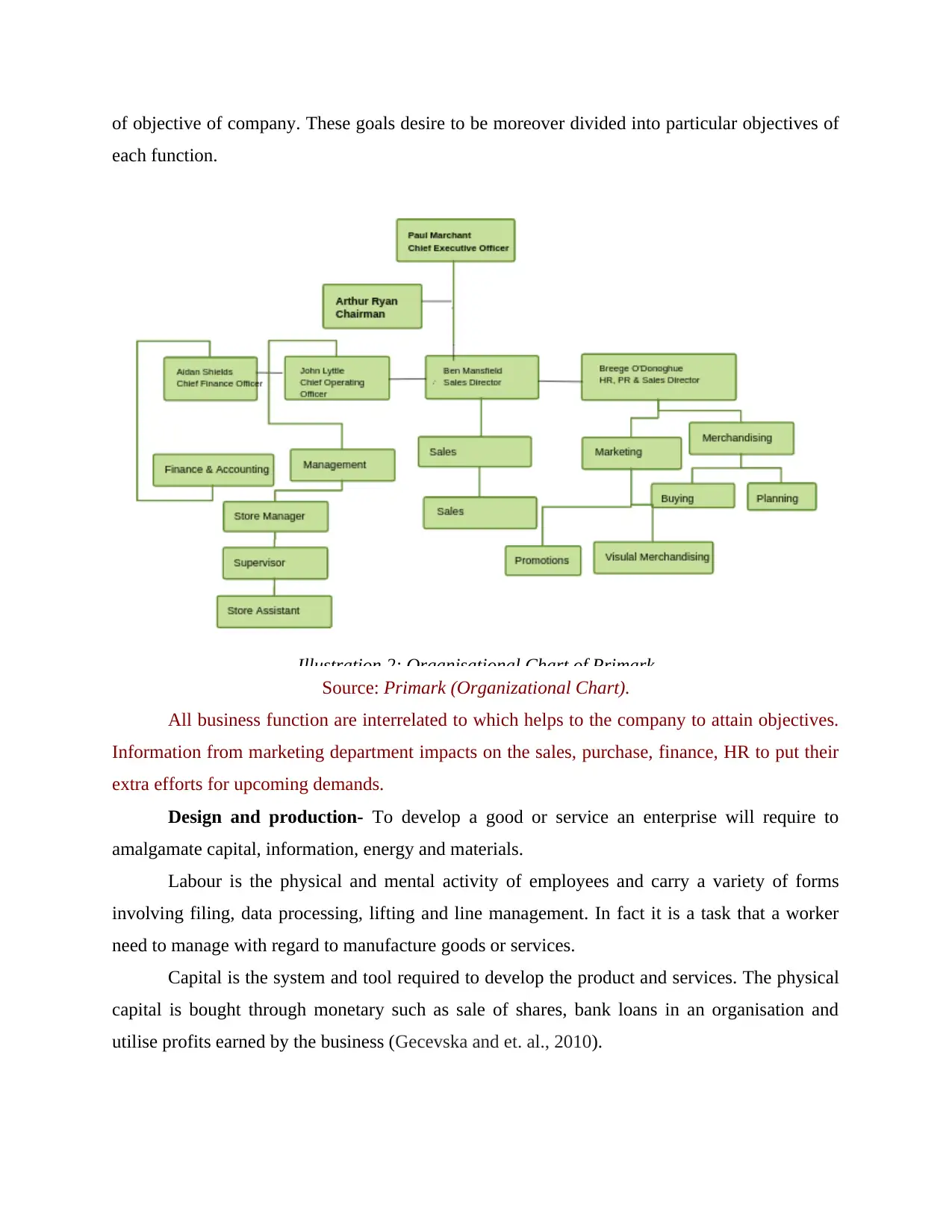
of objective of company. These goals desire to be moreover divided into particular objectives of
each function.
Source: Primark (Organizational Chart).
All business function are interrelated to which helps to the company to attain objectives.
Information from marketing department impacts on the sales, purchase, finance, HR to put their
extra efforts for upcoming demands.
Design and production- To develop a good or service an enterprise will require to
amalgamate capital, information, energy and materials.
Labour is the physical and mental activity of employees and carry a variety of forms
involving filing, data processing, lifting and line management. In fact it is a task that a worker
need to manage with regard to manufacture goods or services.
Capital is the system and tool required to develop the product and services. The physical
capital is bought through monetary such as sale of shares, bank loans in an organisation and
utilise profits earned by the business (Gecevska and et. al., 2010).
Illustration 2: Organisational Chart of Primark
each function.
Source: Primark (Organizational Chart).
All business function are interrelated to which helps to the company to attain objectives.
Information from marketing department impacts on the sales, purchase, finance, HR to put their
extra efforts for upcoming demands.
Design and production- To develop a good or service an enterprise will require to
amalgamate capital, information, energy and materials.
Labour is the physical and mental activity of employees and carry a variety of forms
involving filing, data processing, lifting and line management. In fact it is a task that a worker
need to manage with regard to manufacture goods or services.
Capital is the system and tool required to develop the product and services. The physical
capital is bought through monetary such as sale of shares, bank loans in an organisation and
utilise profits earned by the business (Gecevska and et. al., 2010).
Illustration 2: Organisational Chart of Primark
Secure Best Marks with AI Grader
Need help grading? Try our AI Grader for instant feedback on your assignments.
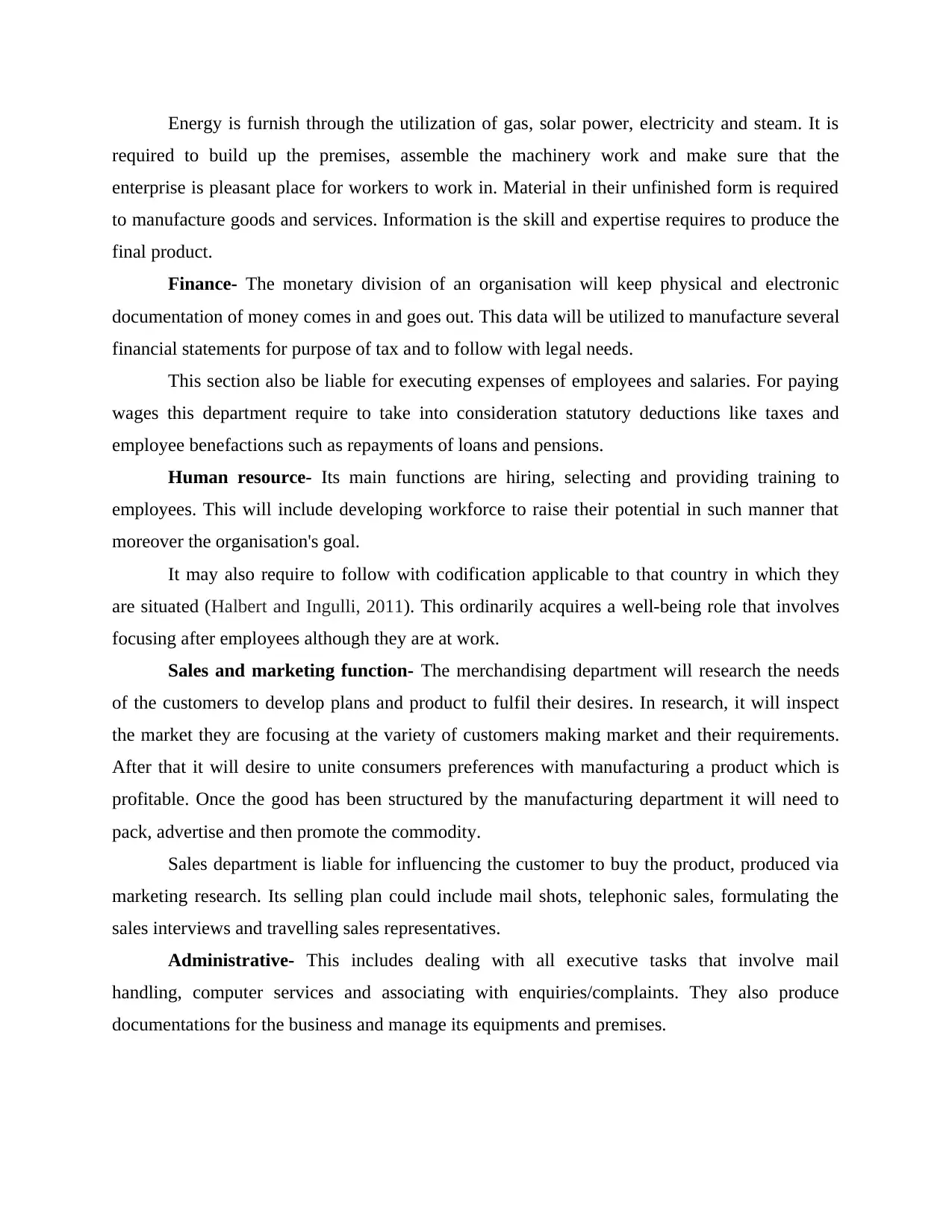
Energy is furnish through the utilization of gas, solar power, electricity and steam. It is
required to build up the premises, assemble the machinery work and make sure that the
enterprise is pleasant place for workers to work in. Material in their unfinished form is required
to manufacture goods and services. Information is the skill and expertise requires to produce the
final product.
Finance- The monetary division of an organisation will keep physical and electronic
documentation of money comes in and goes out. This data will be utilized to manufacture several
financial statements for purpose of tax and to follow with legal needs.
This section also be liable for executing expenses of employees and salaries. For paying
wages this department require to take into consideration statutory deductions like taxes and
employee benefactions such as repayments of loans and pensions.
Human resource- Its main functions are hiring, selecting and providing training to
employees. This will include developing workforce to raise their potential in such manner that
moreover the organisation's goal.
It may also require to follow with codification applicable to that country in which they
are situated (Halbert and Ingulli, 2011). This ordinarily acquires a well-being role that involves
focusing after employees although they are at work.
Sales and marketing function- The merchandising department will research the needs
of the customers to develop plans and product to fulfil their desires. In research, it will inspect
the market they are focusing at the variety of customers making market and their requirements.
After that it will desire to unite consumers preferences with manufacturing a product which is
profitable. Once the good has been structured by the manufacturing department it will need to
pack, advertise and then promote the commodity.
Sales department is liable for influencing the customer to buy the product, produced via
marketing research. Its selling plan could include mail shots, telephonic sales, formulating the
sales interviews and travelling sales representatives.
Administrative- This includes dealing with all executive tasks that involve mail
handling, computer services and associating with enquiries/complaints. They also produce
documentations for the business and manage its equipments and premises.
required to build up the premises, assemble the machinery work and make sure that the
enterprise is pleasant place for workers to work in. Material in their unfinished form is required
to manufacture goods and services. Information is the skill and expertise requires to produce the
final product.
Finance- The monetary division of an organisation will keep physical and electronic
documentation of money comes in and goes out. This data will be utilized to manufacture several
financial statements for purpose of tax and to follow with legal needs.
This section also be liable for executing expenses of employees and salaries. For paying
wages this department require to take into consideration statutory deductions like taxes and
employee benefactions such as repayments of loans and pensions.
Human resource- Its main functions are hiring, selecting and providing training to
employees. This will include developing workforce to raise their potential in such manner that
moreover the organisation's goal.
It may also require to follow with codification applicable to that country in which they
are situated (Halbert and Ingulli, 2011). This ordinarily acquires a well-being role that involves
focusing after employees although they are at work.
Sales and marketing function- The merchandising department will research the needs
of the customers to develop plans and product to fulfil their desires. In research, it will inspect
the market they are focusing at the variety of customers making market and their requirements.
After that it will desire to unite consumers preferences with manufacturing a product which is
profitable. Once the good has been structured by the manufacturing department it will need to
pack, advertise and then promote the commodity.
Sales department is liable for influencing the customer to buy the product, produced via
marketing research. Its selling plan could include mail shots, telephonic sales, formulating the
sales interviews and travelling sales representatives.
Administrative- This includes dealing with all executive tasks that involve mail
handling, computer services and associating with enquiries/complaints. They also produce
documentations for the business and manage its equipments and premises.
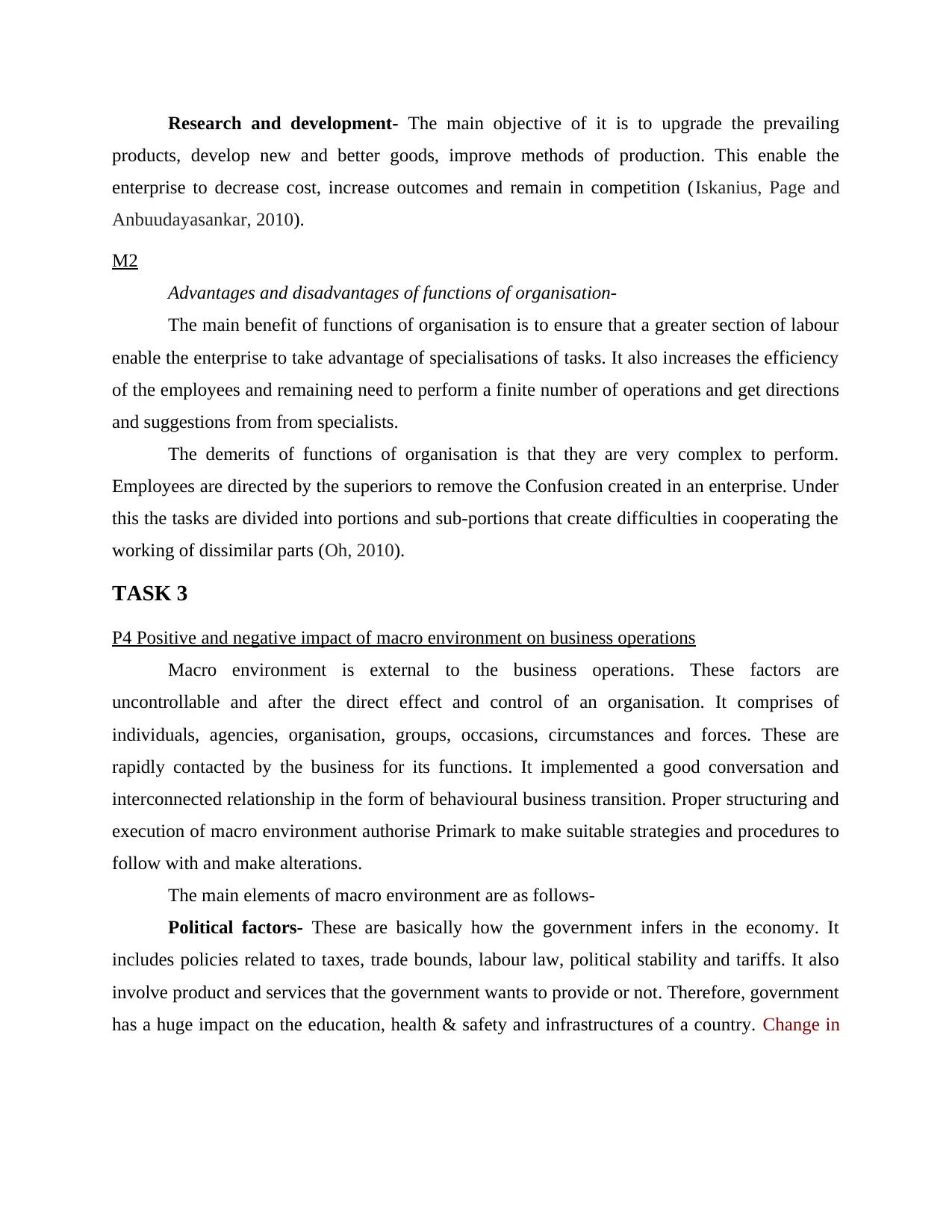
Research and development- The main objective of it is to upgrade the prevailing
products, develop new and better goods, improve methods of production. This enable the
enterprise to decrease cost, increase outcomes and remain in competition (Iskanius, Page and
Anbuudayasankar, 2010).
M2
Advantages and disadvantages of functions of organisation-
The main benefit of functions of organisation is to ensure that a greater section of labour
enable the enterprise to take advantage of specialisations of tasks. It also increases the efficiency
of the employees and remaining need to perform a finite number of operations and get directions
and suggestions from from specialists.
The demerits of functions of organisation is that they are very complex to perform.
Employees are directed by the superiors to remove the Confusion created in an enterprise. Under
this the tasks are divided into portions and sub-portions that create difficulties in cooperating the
working of dissimilar parts (Oh, 2010).
TASK 3
P4 Positive and negative impact of macro environment on business operations
Macro environment is external to the business operations. These factors are
uncontrollable and after the direct effect and control of an organisation. It comprises of
individuals, agencies, organisation, groups, occasions, circumstances and forces. These are
rapidly contacted by the business for its functions. It implemented a good conversation and
interconnected relationship in the form of behavioural business transition. Proper structuring and
execution of macro environment authorise Primark to make suitable strategies and procedures to
follow with and make alterations.
The main elements of macro environment are as follows-
Political factors- These are basically how the government infers in the economy. It
includes policies related to taxes, trade bounds, labour law, political stability and tariffs. It also
involve product and services that the government wants to provide or not. Therefore, government
has a huge impact on the education, health & safety and infrastructures of a country. Change in
products, develop new and better goods, improve methods of production. This enable the
enterprise to decrease cost, increase outcomes and remain in competition (Iskanius, Page and
Anbuudayasankar, 2010).
M2
Advantages and disadvantages of functions of organisation-
The main benefit of functions of organisation is to ensure that a greater section of labour
enable the enterprise to take advantage of specialisations of tasks. It also increases the efficiency
of the employees and remaining need to perform a finite number of operations and get directions
and suggestions from from specialists.
The demerits of functions of organisation is that they are very complex to perform.
Employees are directed by the superiors to remove the Confusion created in an enterprise. Under
this the tasks are divided into portions and sub-portions that create difficulties in cooperating the
working of dissimilar parts (Oh, 2010).
TASK 3
P4 Positive and negative impact of macro environment on business operations
Macro environment is external to the business operations. These factors are
uncontrollable and after the direct effect and control of an organisation. It comprises of
individuals, agencies, organisation, groups, occasions, circumstances and forces. These are
rapidly contacted by the business for its functions. It implemented a good conversation and
interconnected relationship in the form of behavioural business transition. Proper structuring and
execution of macro environment authorise Primark to make suitable strategies and procedures to
follow with and make alterations.
The main elements of macro environment are as follows-
Political factors- These are basically how the government infers in the economy. It
includes policies related to taxes, trade bounds, labour law, political stability and tariffs. It also
involve product and services that the government wants to provide or not. Therefore, government
has a huge impact on the education, health & safety and infrastructures of a country. Change in
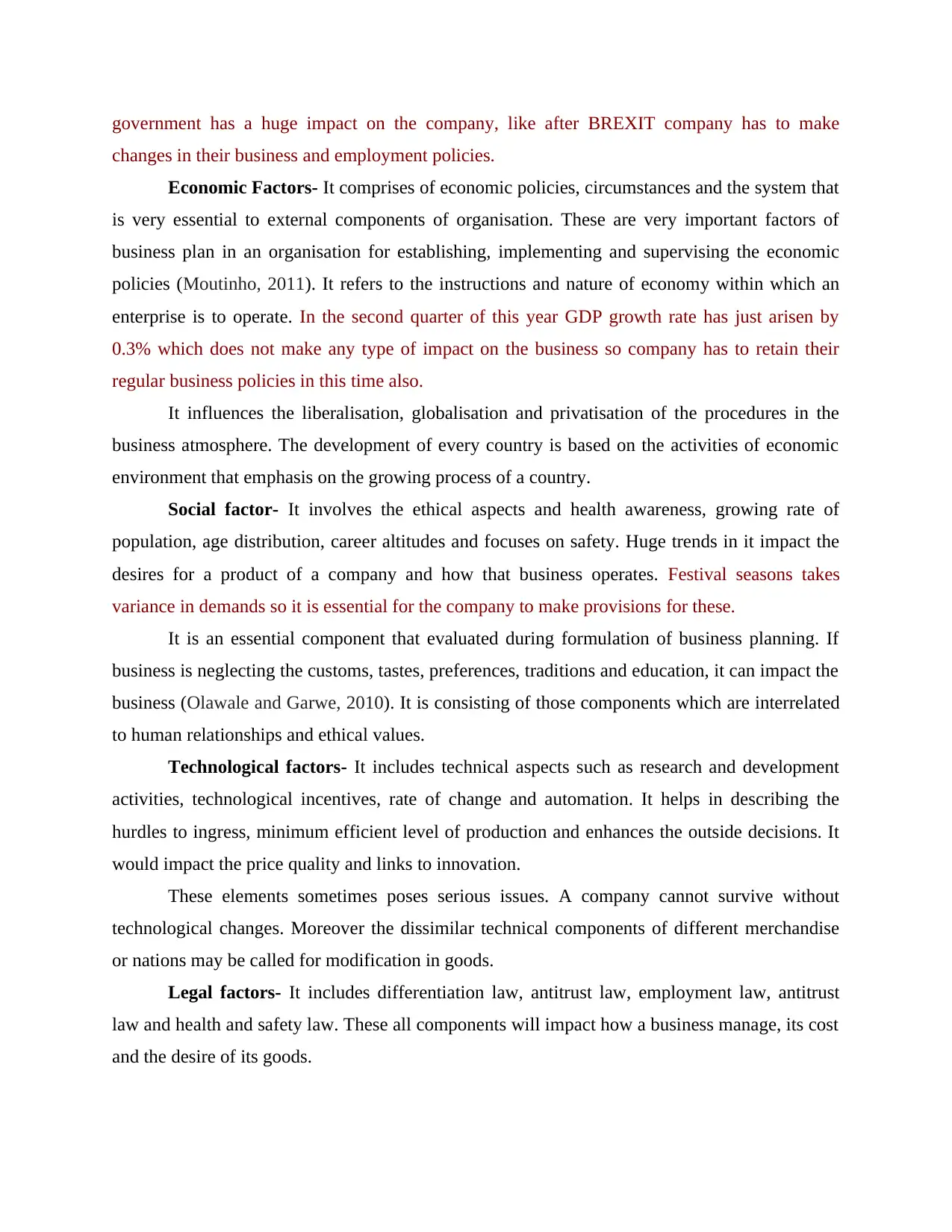
government has a huge impact on the company, like after BREXIT company has to make
changes in their business and employment policies.
Economic Factors- It comprises of economic policies, circumstances and the system that
is very essential to external components of organisation. These are very important factors of
business plan in an organisation for establishing, implementing and supervising the economic
policies (Moutinho, 2011). It refers to the instructions and nature of economy within which an
enterprise is to operate. In the second quarter of this year GDP growth rate has just arisen by
0.3% which does not make any type of impact on the business so company has to retain their
regular business policies in this time also.
It influences the liberalisation, globalisation and privatisation of the procedures in the
business atmosphere. The development of every country is based on the activities of economic
environment that emphasis on the growing process of a country.
Social factor- It involves the ethical aspects and health awareness, growing rate of
population, age distribution, career altitudes and focuses on safety. Huge trends in it impact the
desires for a product of a company and how that business operates. Festival seasons takes
variance in demands so it is essential for the company to make provisions for these.
It is an essential component that evaluated during formulation of business planning. If
business is neglecting the customs, tastes, preferences, traditions and education, it can impact the
business (Olawale and Garwe, 2010). It is consisting of those components which are interrelated
to human relationships and ethical values.
Technological factors- It includes technical aspects such as research and development
activities, technological incentives, rate of change and automation. It helps in describing the
hurdles to ingress, minimum efficient level of production and enhances the outside decisions. It
would impact the price quality and links to innovation.
These elements sometimes poses serious issues. A company cannot survive without
technological changes. Moreover the dissimilar technical components of different merchandise
or nations may be called for modification in goods.
Legal factors- It includes differentiation law, antitrust law, employment law, antitrust
law and health and safety law. These all components will impact how a business manage, its cost
and the desire of its goods.
changes in their business and employment policies.
Economic Factors- It comprises of economic policies, circumstances and the system that
is very essential to external components of organisation. These are very important factors of
business plan in an organisation for establishing, implementing and supervising the economic
policies (Moutinho, 2011). It refers to the instructions and nature of economy within which an
enterprise is to operate. In the second quarter of this year GDP growth rate has just arisen by
0.3% which does not make any type of impact on the business so company has to retain their
regular business policies in this time also.
It influences the liberalisation, globalisation and privatisation of the procedures in the
business atmosphere. The development of every country is based on the activities of economic
environment that emphasis on the growing process of a country.
Social factor- It involves the ethical aspects and health awareness, growing rate of
population, age distribution, career altitudes and focuses on safety. Huge trends in it impact the
desires for a product of a company and how that business operates. Festival seasons takes
variance in demands so it is essential for the company to make provisions for these.
It is an essential component that evaluated during formulation of business planning. If
business is neglecting the customs, tastes, preferences, traditions and education, it can impact the
business (Olawale and Garwe, 2010). It is consisting of those components which are interrelated
to human relationships and ethical values.
Technological factors- It includes technical aspects such as research and development
activities, technological incentives, rate of change and automation. It helps in describing the
hurdles to ingress, minimum efficient level of production and enhances the outside decisions. It
would impact the price quality and links to innovation.
These elements sometimes poses serious issues. A company cannot survive without
technological changes. Moreover the dissimilar technical components of different merchandise
or nations may be called for modification in goods.
Legal factors- It includes differentiation law, antitrust law, employment law, antitrust
law and health and safety law. These all components will impact how a business manage, its cost
and the desire of its goods.
Paraphrase This Document
Need a fresh take? Get an instant paraphrase of this document with our AI Paraphraser
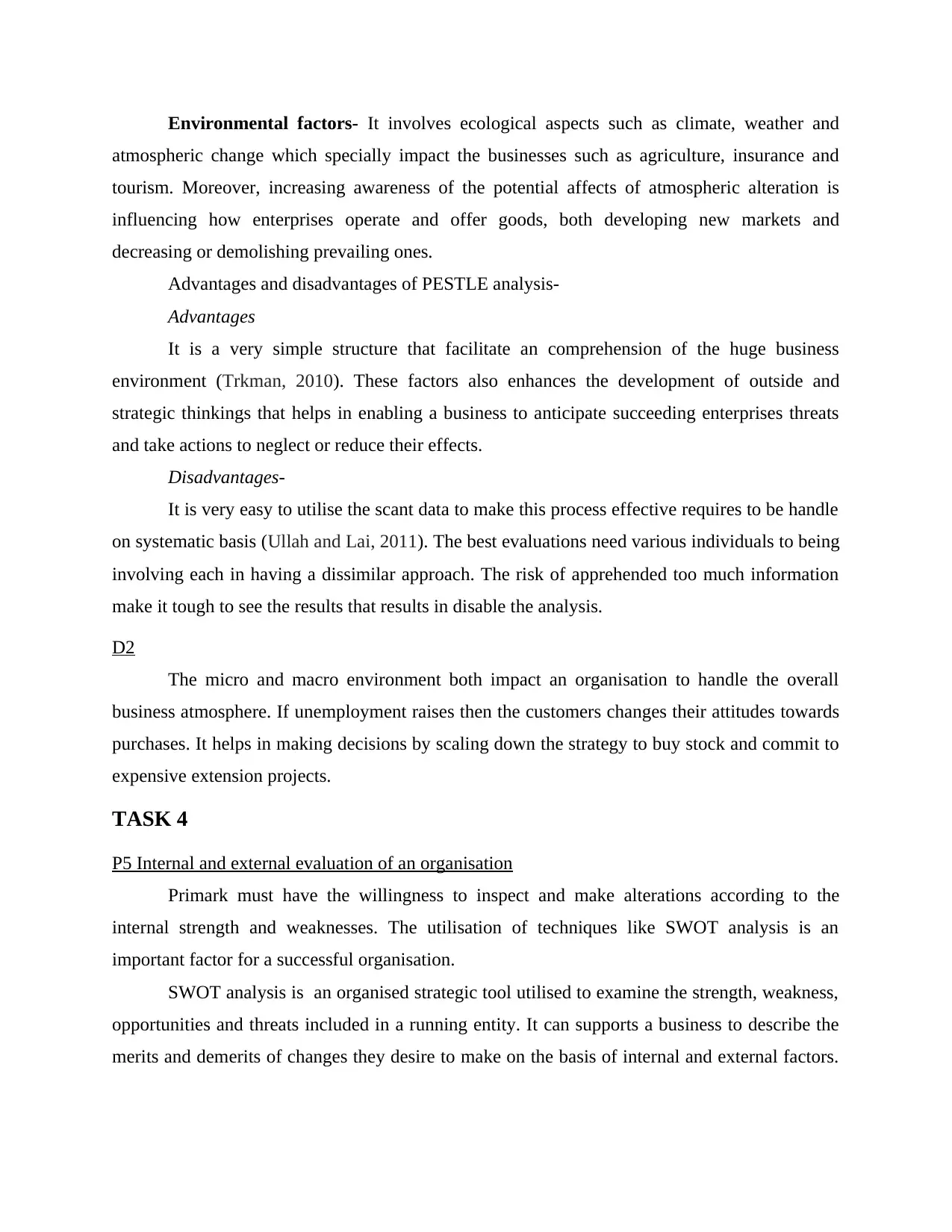
Environmental factors- It involves ecological aspects such as climate, weather and
atmospheric change which specially impact the businesses such as agriculture, insurance and
tourism. Moreover, increasing awareness of the potential affects of atmospheric alteration is
influencing how enterprises operate and offer goods, both developing new markets and
decreasing or demolishing prevailing ones.
Advantages and disadvantages of PESTLE analysis-
Advantages
It is a very simple structure that facilitate an comprehension of the huge business
environment (Trkman, 2010). These factors also enhances the development of outside and
strategic thinkings that helps in enabling a business to anticipate succeeding enterprises threats
and take actions to neglect or reduce their effects.
Disadvantages-
It is very easy to utilise the scant data to make this process effective requires to be handle
on systematic basis (Ullah and Lai, 2011). The best evaluations need various individuals to being
involving each in having a dissimilar approach. The risk of apprehended too much information
make it tough to see the results that results in disable the analysis.
D2
The micro and macro environment both impact an organisation to handle the overall
business atmosphere. If unemployment raises then the customers changes their attitudes towards
purchases. It helps in making decisions by scaling down the strategy to buy stock and commit to
expensive extension projects.
TASK 4
P5 Internal and external evaluation of an organisation
Primark must have the willingness to inspect and make alterations according to the
internal strength and weaknesses. The utilisation of techniques like SWOT analysis is an
important factor for a successful organisation.
SWOT analysis is an organised strategic tool utilised to examine the strength, weakness,
opportunities and threats included in a running entity. It can supports a business to describe the
merits and demerits of changes they desire to make on the basis of internal and external factors.
atmospheric change which specially impact the businesses such as agriculture, insurance and
tourism. Moreover, increasing awareness of the potential affects of atmospheric alteration is
influencing how enterprises operate and offer goods, both developing new markets and
decreasing or demolishing prevailing ones.
Advantages and disadvantages of PESTLE analysis-
Advantages
It is a very simple structure that facilitate an comprehension of the huge business
environment (Trkman, 2010). These factors also enhances the development of outside and
strategic thinkings that helps in enabling a business to anticipate succeeding enterprises threats
and take actions to neglect or reduce their effects.
Disadvantages-
It is very easy to utilise the scant data to make this process effective requires to be handle
on systematic basis (Ullah and Lai, 2011). The best evaluations need various individuals to being
involving each in having a dissimilar approach. The risk of apprehended too much information
make it tough to see the results that results in disable the analysis.
D2
The micro and macro environment both impact an organisation to handle the overall
business atmosphere. If unemployment raises then the customers changes their attitudes towards
purchases. It helps in making decisions by scaling down the strategy to buy stock and commit to
expensive extension projects.
TASK 4
P5 Internal and external evaluation of an organisation
Primark must have the willingness to inspect and make alterations according to the
internal strength and weaknesses. The utilisation of techniques like SWOT analysis is an
important factor for a successful organisation.
SWOT analysis is an organised strategic tool utilised to examine the strength, weakness,
opportunities and threats included in a running entity. It can supports a business to describe the
merits and demerits of changes they desire to make on the basis of internal and external factors.
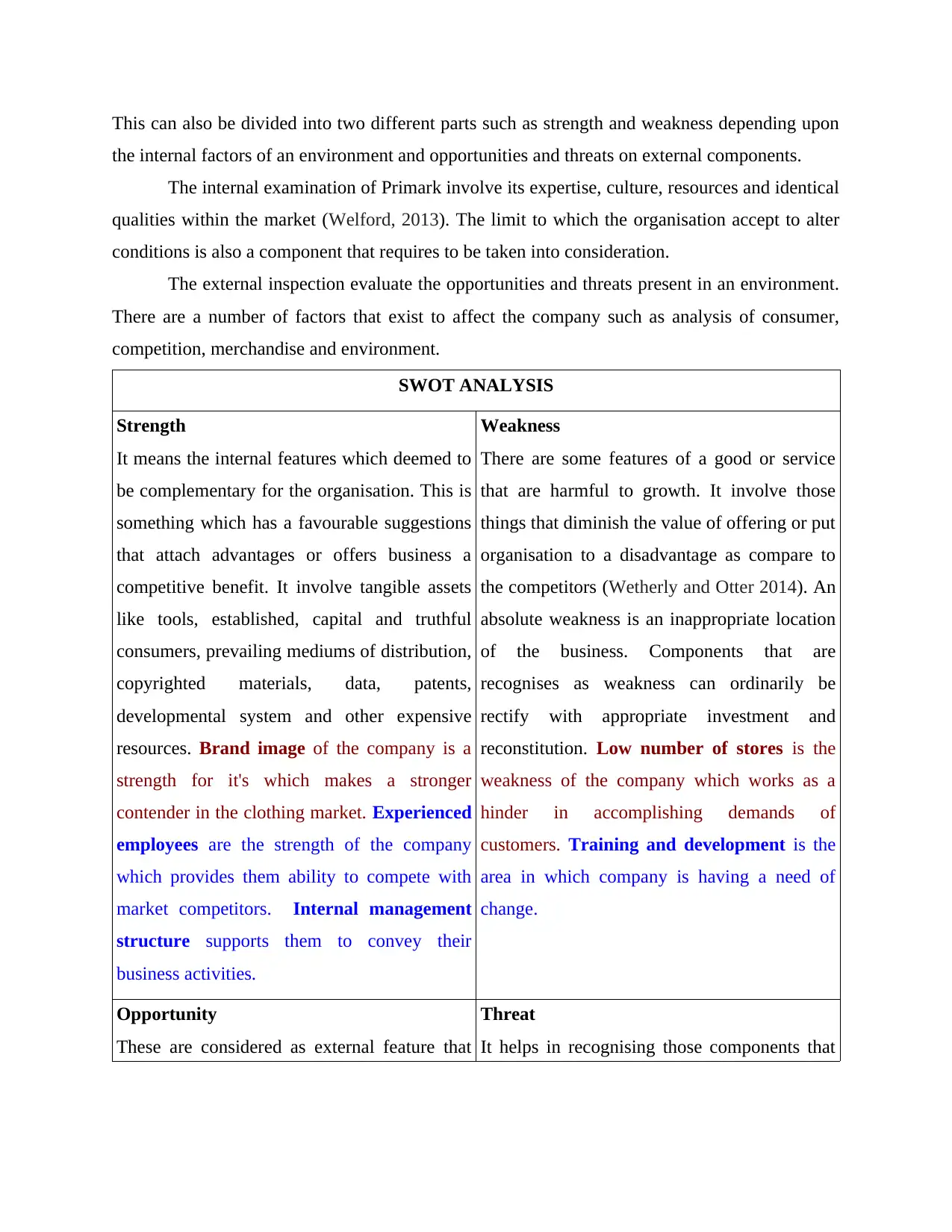
This can also be divided into two different parts such as strength and weakness depending upon
the internal factors of an environment and opportunities and threats on external components.
The internal examination of Primark involve its expertise, culture, resources and identical
qualities within the market (Welford, 2013). The limit to which the organisation accept to alter
conditions is also a component that requires to be taken into consideration.
The external inspection evaluate the opportunities and threats present in an environment.
There are a number of factors that exist to affect the company such as analysis of consumer,
competition, merchandise and environment.
SWOT ANALYSIS
Strength
It means the internal features which deemed to
be complementary for the organisation. This is
something which has a favourable suggestions
that attach advantages or offers business a
competitive benefit. It involve tangible assets
like tools, established, capital and truthful
consumers, prevailing mediums of distribution,
copyrighted materials, data, patents,
developmental system and other expensive
resources. Brand image of the company is a
strength for it's which makes a stronger
contender in the clothing market. Experienced
employees are the strength of the company
which provides them ability to compete with
market competitors. Internal management
structure supports them to convey their
business activities.
Weakness
There are some features of a good or service
that are harmful to growth. It involve those
things that diminish the value of offering or put
organisation to a disadvantage as compare to
the competitors (Wetherly and Otter 2014). An
absolute weakness is an inappropriate location
of the business. Components that are
recognises as weakness can ordinarily be
rectify with appropriate investment and
reconstitution. Low number of stores is the
weakness of the company which works as a
hinder in accomplishing demands of
customers. Training and development is the
area in which company is having a need of
change.
Opportunity
These are considered as external feature that
Threat
It helps in recognising those components that
the internal factors of an environment and opportunities and threats on external components.
The internal examination of Primark involve its expertise, culture, resources and identical
qualities within the market (Welford, 2013). The limit to which the organisation accept to alter
conditions is also a component that requires to be taken into consideration.
The external inspection evaluate the opportunities and threats present in an environment.
There are a number of factors that exist to affect the company such as analysis of consumer,
competition, merchandise and environment.
SWOT ANALYSIS
Strength
It means the internal features which deemed to
be complementary for the organisation. This is
something which has a favourable suggestions
that attach advantages or offers business a
competitive benefit. It involve tangible assets
like tools, established, capital and truthful
consumers, prevailing mediums of distribution,
copyrighted materials, data, patents,
developmental system and other expensive
resources. Brand image of the company is a
strength for it's which makes a stronger
contender in the clothing market. Experienced
employees are the strength of the company
which provides them ability to compete with
market competitors. Internal management
structure supports them to convey their
business activities.
Weakness
There are some features of a good or service
that are harmful to growth. It involve those
things that diminish the value of offering or put
organisation to a disadvantage as compare to
the competitors (Wetherly and Otter 2014). An
absolute weakness is an inappropriate location
of the business. Components that are
recognises as weakness can ordinarily be
rectify with appropriate investment and
reconstitution. Low number of stores is the
weakness of the company which works as a
hinder in accomplishing demands of
customers. Training and development is the
area in which company is having a need of
change.
Opportunity
These are considered as external feature that
Threat
It helps in recognising those components that
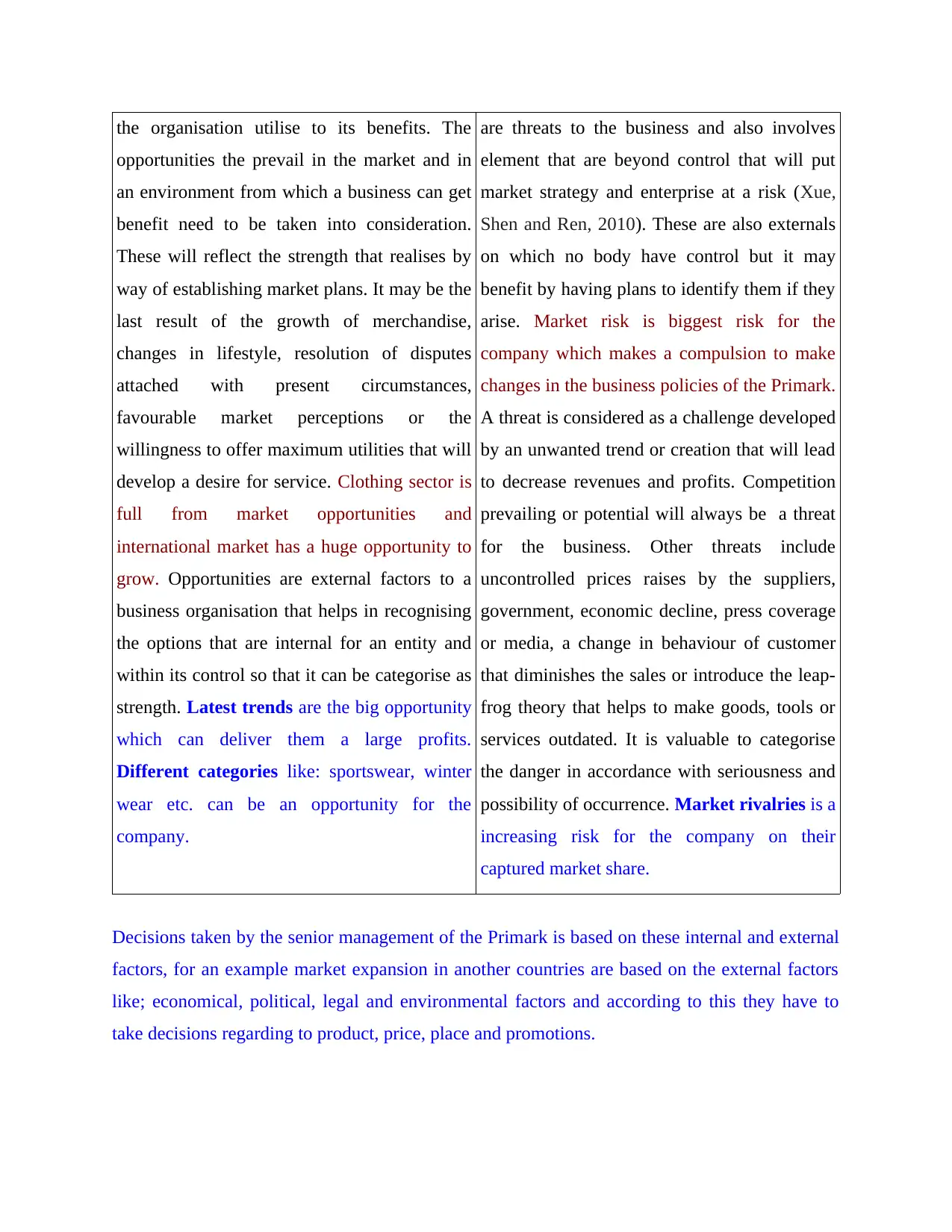
the organisation utilise to its benefits. The
opportunities the prevail in the market and in
an environment from which a business can get
benefit need to be taken into consideration.
These will reflect the strength that realises by
way of establishing market plans. It may be the
last result of the growth of merchandise,
changes in lifestyle, resolution of disputes
attached with present circumstances,
favourable market perceptions or the
willingness to offer maximum utilities that will
develop a desire for service. Clothing sector is
full from market opportunities and
international market has a huge opportunity to
grow. Opportunities are external factors to a
business organisation that helps in recognising
the options that are internal for an entity and
within its control so that it can be categorise as
strength. Latest trends are the big opportunity
which can deliver them a large profits.
Different categories like: sportswear, winter
wear etc. can be an opportunity for the
company.
are threats to the business and also involves
element that are beyond control that will put
market strategy and enterprise at a risk (Xue,
Shen and Ren, 2010). These are also externals
on which no body have control but it may
benefit by having plans to identify them if they
arise. Market risk is biggest risk for the
company which makes a compulsion to make
changes in the business policies of the Primark.
A threat is considered as a challenge developed
by an unwanted trend or creation that will lead
to decrease revenues and profits. Competition
prevailing or potential will always be a threat
for the business. Other threats include
uncontrolled prices raises by the suppliers,
government, economic decline, press coverage
or media, a change in behaviour of customer
that diminishes the sales or introduce the leap-
frog theory that helps to make goods, tools or
services outdated. It is valuable to categorise
the danger in accordance with seriousness and
possibility of occurrence. Market rivalries is a
increasing risk for the company on their
captured market share.
Decisions taken by the senior management of the Primark is based on these internal and external
factors, for an example market expansion in another countries are based on the external factors
like; economical, political, legal and environmental factors and according to this they have to
take decisions regarding to product, price, place and promotions.
opportunities the prevail in the market and in
an environment from which a business can get
benefit need to be taken into consideration.
These will reflect the strength that realises by
way of establishing market plans. It may be the
last result of the growth of merchandise,
changes in lifestyle, resolution of disputes
attached with present circumstances,
favourable market perceptions or the
willingness to offer maximum utilities that will
develop a desire for service. Clothing sector is
full from market opportunities and
international market has a huge opportunity to
grow. Opportunities are external factors to a
business organisation that helps in recognising
the options that are internal for an entity and
within its control so that it can be categorise as
strength. Latest trends are the big opportunity
which can deliver them a large profits.
Different categories like: sportswear, winter
wear etc. can be an opportunity for the
company.
are threats to the business and also involves
element that are beyond control that will put
market strategy and enterprise at a risk (Xue,
Shen and Ren, 2010). These are also externals
on which no body have control but it may
benefit by having plans to identify them if they
arise. Market risk is biggest risk for the
company which makes a compulsion to make
changes in the business policies of the Primark.
A threat is considered as a challenge developed
by an unwanted trend or creation that will lead
to decrease revenues and profits. Competition
prevailing or potential will always be a threat
for the business. Other threats include
uncontrolled prices raises by the suppliers,
government, economic decline, press coverage
or media, a change in behaviour of customer
that diminishes the sales or introduce the leap-
frog theory that helps to make goods, tools or
services outdated. It is valuable to categorise
the danger in accordance with seriousness and
possibility of occurrence. Market rivalries is a
increasing risk for the company on their
captured market share.
Decisions taken by the senior management of the Primark is based on these internal and external
factors, for an example market expansion in another countries are based on the external factors
like; economical, political, legal and environmental factors and according to this they have to
take decisions regarding to product, price, place and promotions.
Secure Best Marks with AI Grader
Need help grading? Try our AI Grader for instant feedback on your assignments.
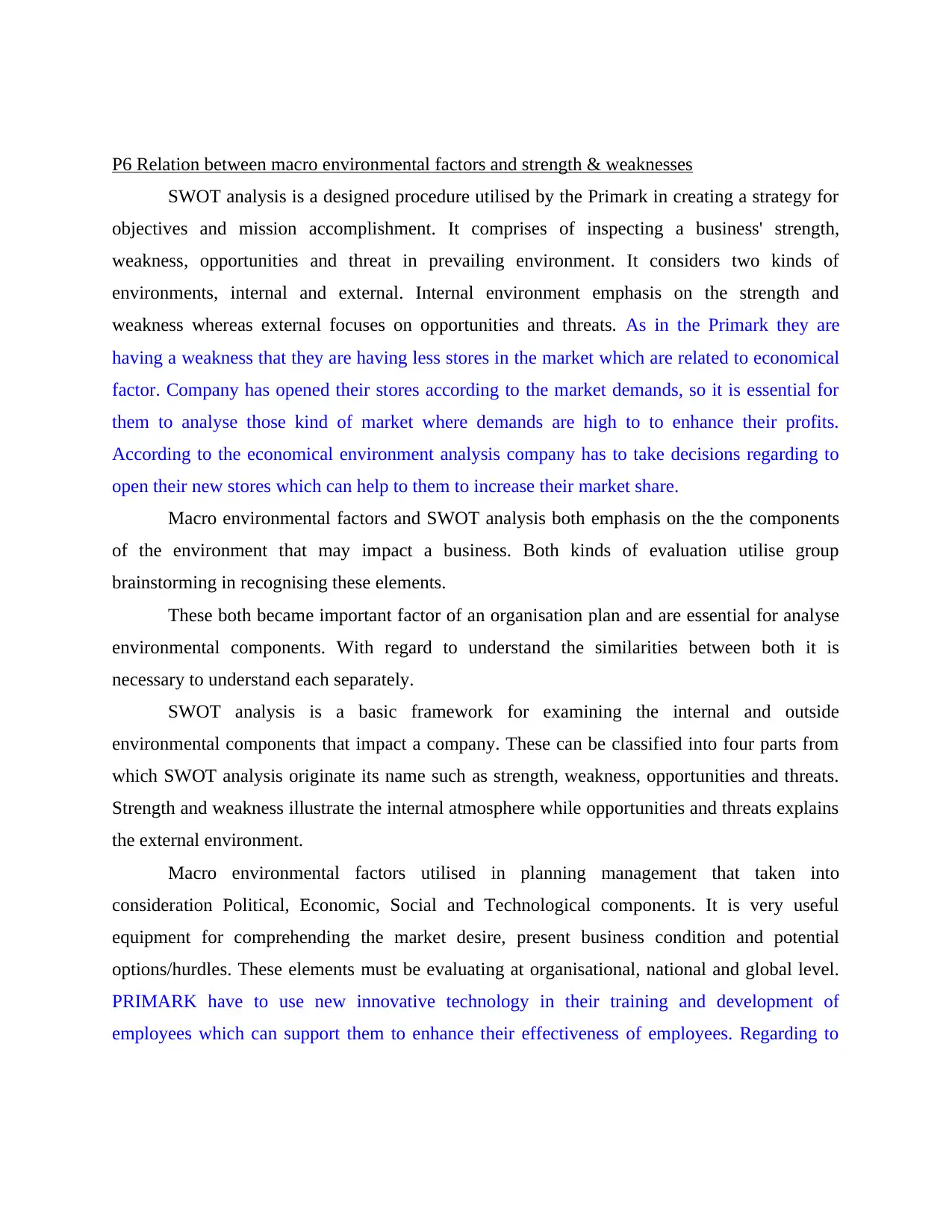
P6 Relation between macro environmental factors and strength & weaknesses
SWOT analysis is a designed procedure utilised by the Primark in creating a strategy for
objectives and mission accomplishment. It comprises of inspecting a business' strength,
weakness, opportunities and threat in prevailing environment. It considers two kinds of
environments, internal and external. Internal environment emphasis on the strength and
weakness whereas external focuses on opportunities and threats. As in the Primark they are
having a weakness that they are having less stores in the market which are related to economical
factor. Company has opened their stores according to the market demands, so it is essential for
them to analyse those kind of market where demands are high to to enhance their profits.
According to the economical environment analysis company has to take decisions regarding to
open their new stores which can help to them to increase their market share.
Macro environmental factors and SWOT analysis both emphasis on the the components
of the environment that may impact a business. Both kinds of evaluation utilise group
brainstorming in recognising these elements.
These both became important factor of an organisation plan and are essential for analyse
environmental components. With regard to understand the similarities between both it is
necessary to understand each separately.
SWOT analysis is a basic framework for examining the internal and outside
environmental components that impact a company. These can be classified into four parts from
which SWOT analysis originate its name such as strength, weakness, opportunities and threats.
Strength and weakness illustrate the internal atmosphere while opportunities and threats explains
the external environment.
Macro environmental factors utilised in planning management that taken into
consideration Political, Economic, Social and Technological components. It is very useful
equipment for comprehending the market desire, present business condition and potential
options/hurdles. These elements must be evaluating at organisational, national and global level.
PRIMARK have to use new innovative technology in their training and development of
employees which can support them to enhance their effectiveness of employees. Regarding to
SWOT analysis is a designed procedure utilised by the Primark in creating a strategy for
objectives and mission accomplishment. It comprises of inspecting a business' strength,
weakness, opportunities and threat in prevailing environment. It considers two kinds of
environments, internal and external. Internal environment emphasis on the strength and
weakness whereas external focuses on opportunities and threats. As in the Primark they are
having a weakness that they are having less stores in the market which are related to economical
factor. Company has opened their stores according to the market demands, so it is essential for
them to analyse those kind of market where demands are high to to enhance their profits.
According to the economical environment analysis company has to take decisions regarding to
open their new stores which can help to them to increase their market share.
Macro environmental factors and SWOT analysis both emphasis on the the components
of the environment that may impact a business. Both kinds of evaluation utilise group
brainstorming in recognising these elements.
These both became important factor of an organisation plan and are essential for analyse
environmental components. With regard to understand the similarities between both it is
necessary to understand each separately.
SWOT analysis is a basic framework for examining the internal and outside
environmental components that impact a company. These can be classified into four parts from
which SWOT analysis originate its name such as strength, weakness, opportunities and threats.
Strength and weakness illustrate the internal atmosphere while opportunities and threats explains
the external environment.
Macro environmental factors utilised in planning management that taken into
consideration Political, Economic, Social and Technological components. It is very useful
equipment for comprehending the market desire, present business condition and potential
options/hurdles. These elements must be evaluating at organisational, national and global level.
PRIMARK have to use new innovative technology in their training and development of
employees which can support them to enhance their effectiveness of employees. Regarding to
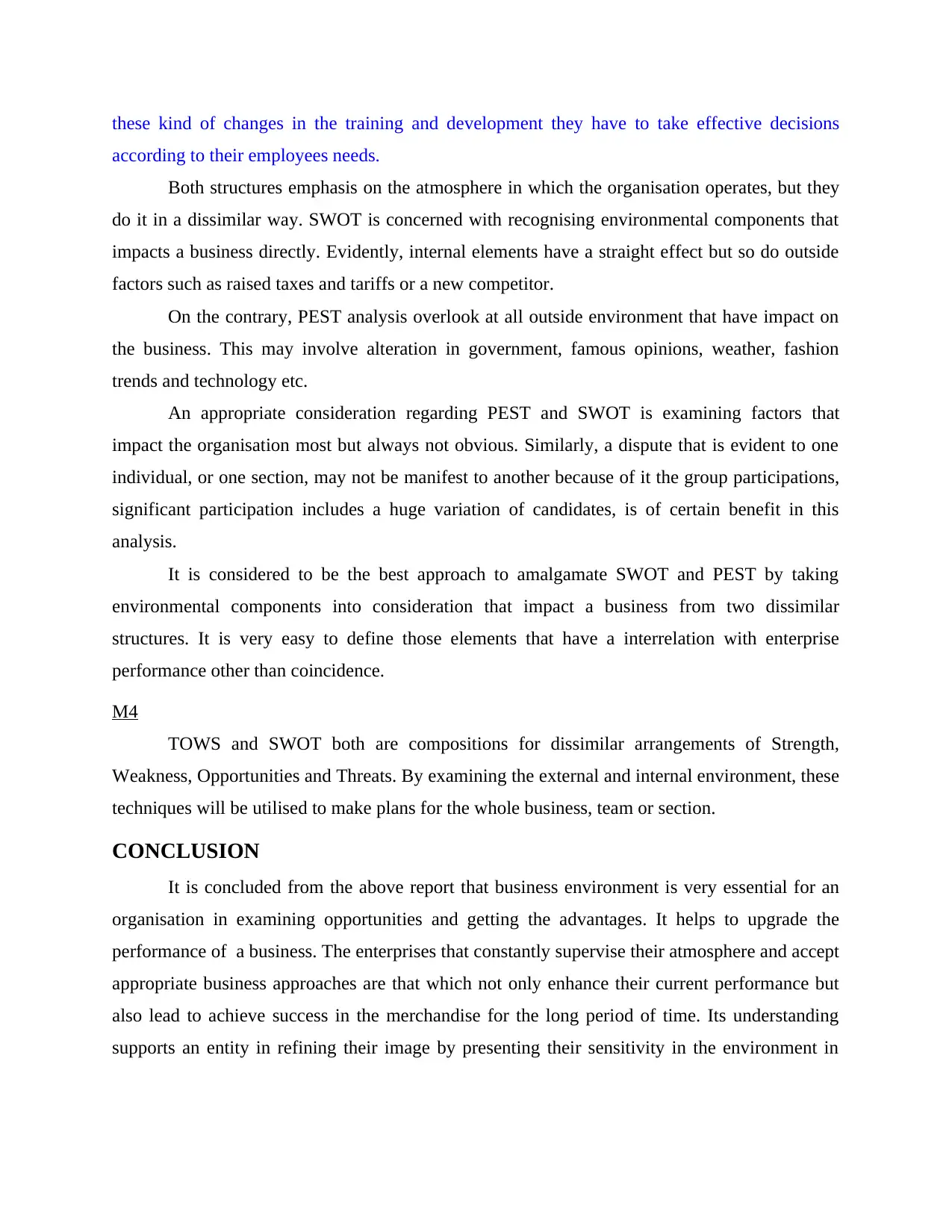
these kind of changes in the training and development they have to take effective decisions
according to their employees needs.
Both structures emphasis on the atmosphere in which the organisation operates, but they
do it in a dissimilar way. SWOT is concerned with recognising environmental components that
impacts a business directly. Evidently, internal elements have a straight effect but so do outside
factors such as raised taxes and tariffs or a new competitor.
On the contrary, PEST analysis overlook at all outside environment that have impact on
the business. This may involve alteration in government, famous opinions, weather, fashion
trends and technology etc.
An appropriate consideration regarding PEST and SWOT is examining factors that
impact the organisation most but always not obvious. Similarly, a dispute that is evident to one
individual, or one section, may not be manifest to another because of it the group participations,
significant participation includes a huge variation of candidates, is of certain benefit in this
analysis.
It is considered to be the best approach to amalgamate SWOT and PEST by taking
environmental components into consideration that impact a business from two dissimilar
structures. It is very easy to define those elements that have a interrelation with enterprise
performance other than coincidence.
M4
TOWS and SWOT both are compositions for dissimilar arrangements of Strength,
Weakness, Opportunities and Threats. By examining the external and internal environment, these
techniques will be utilised to make plans for the whole business, team or section.
CONCLUSION
It is concluded from the above report that business environment is very essential for an
organisation in examining opportunities and getting the advantages. It helps to upgrade the
performance of a business. The enterprises that constantly supervise their atmosphere and accept
appropriate business approaches are that which not only enhance their current performance but
also lead to achieve success in the merchandise for the long period of time. Its understanding
supports an entity in refining their image by presenting their sensitivity in the environment in
according to their employees needs.
Both structures emphasis on the atmosphere in which the organisation operates, but they
do it in a dissimilar way. SWOT is concerned with recognising environmental components that
impacts a business directly. Evidently, internal elements have a straight effect but so do outside
factors such as raised taxes and tariffs or a new competitor.
On the contrary, PEST analysis overlook at all outside environment that have impact on
the business. This may involve alteration in government, famous opinions, weather, fashion
trends and technology etc.
An appropriate consideration regarding PEST and SWOT is examining factors that
impact the organisation most but always not obvious. Similarly, a dispute that is evident to one
individual, or one section, may not be manifest to another because of it the group participations,
significant participation includes a huge variation of candidates, is of certain benefit in this
analysis.
It is considered to be the best approach to amalgamate SWOT and PEST by taking
environmental components into consideration that impact a business from two dissimilar
structures. It is very easy to define those elements that have a interrelation with enterprise
performance other than coincidence.
M4
TOWS and SWOT both are compositions for dissimilar arrangements of Strength,
Weakness, Opportunities and Threats. By examining the external and internal environment, these
techniques will be utilised to make plans for the whole business, team or section.
CONCLUSION
It is concluded from the above report that business environment is very essential for an
organisation in examining opportunities and getting the advantages. It helps to upgrade the
performance of a business. The enterprises that constantly supervise their atmosphere and accept
appropriate business approaches are that which not only enhance their current performance but
also lead to achieve success in the merchandise for the long period of time. Its understanding
supports an entity in refining their image by presenting their sensitivity in the environment in
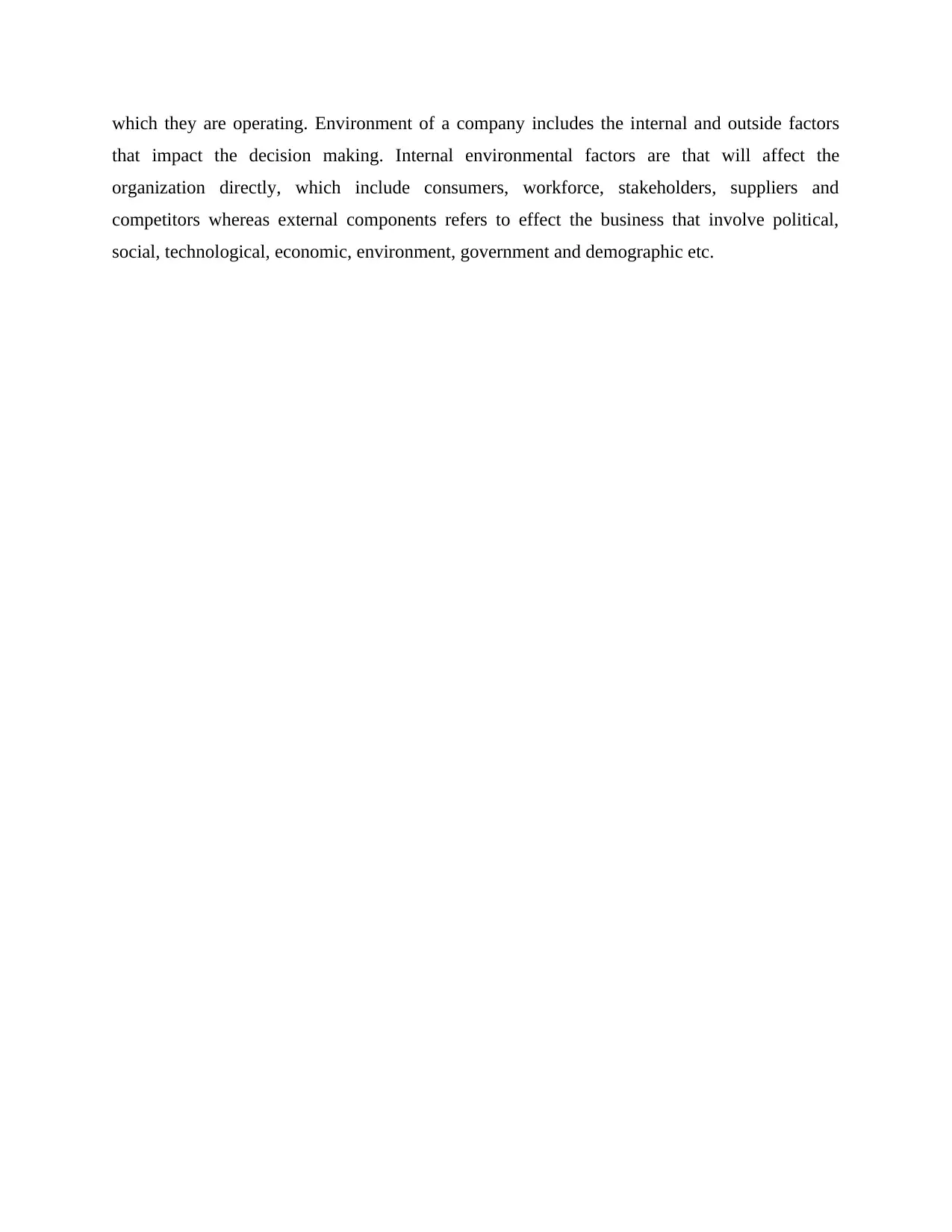
which they are operating. Environment of a company includes the internal and outside factors
that impact the decision making. Internal environmental factors are that will affect the
organization directly, which include consumers, workforce, stakeholders, suppliers and
competitors whereas external components refers to effect the business that involve political,
social, technological, economic, environment, government and demographic etc.
that impact the decision making. Internal environmental factors are that will affect the
organization directly, which include consumers, workforce, stakeholders, suppliers and
competitors whereas external components refers to effect the business that involve political,
social, technological, economic, environment, government and demographic etc.
Paraphrase This Document
Need a fresh take? Get an instant paraphrase of this document with our AI Paraphraser
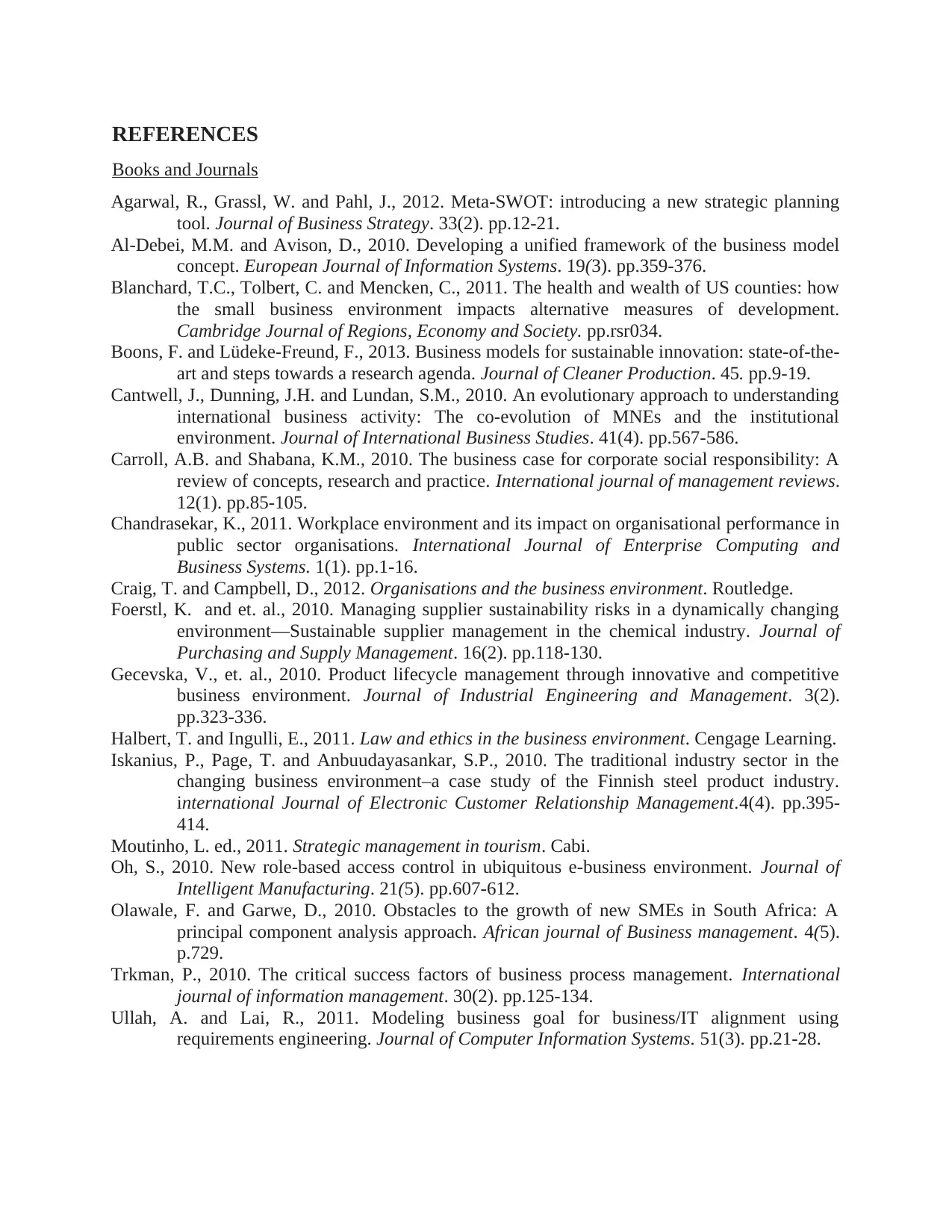
REFERENCES
Books and Journals
Agarwal, R., Grassl, W. and Pahl, J., 2012. Meta-SWOT: introducing a new strategic planning
tool. Journal of Business Strategy. 33(2). pp.12-21.
Al-Debei, M.M. and Avison, D., 2010. Developing a unified framework of the business model
concept. European Journal of Information Systems. 19(3). pp.359-376.
Blanchard, T.C., Tolbert, C. and Mencken, C., 2011. The health and wealth of US counties: how
the small business environment impacts alternative measures of development.
Cambridge Journal of Regions, Economy and Society. pp.rsr034.
Boons, F. and Lüdeke-Freund, F., 2013. Business models for sustainable innovation: state-of-the-
art and steps towards a research agenda. Journal of Cleaner Production. 45. pp.9-19.
Cantwell, J., Dunning, J.H. and Lundan, S.M., 2010. An evolutionary approach to understanding
international business activity: The co-evolution of MNEs and the institutional
environment. Journal of International Business Studies. 41(4). pp.567-586.
Carroll, A.B. and Shabana, K.M., 2010. The business case for corporate social responsibility: A
review of concepts, research and practice. International journal of management reviews.
12(1). pp.85-105.
Chandrasekar, K., 2011. Workplace environment and its impact on organisational performance in
public sector organisations. International Journal of Enterprise Computing and
Business Systems. 1(1). pp.1-16.
Craig, T. and Campbell, D., 2012. Organisations and the business environment. Routledge.
Foerstl, K. and et. al., 2010. Managing supplier sustainability risks in a dynamically changing
environment—Sustainable supplier management in the chemical industry. Journal of
Purchasing and Supply Management. 16(2). pp.118-130.
Gecevska, V., et. al., 2010. Product lifecycle management through innovative and competitive
business environment. Journal of Industrial Engineering and Management. 3(2).
pp.323-336.
Halbert, T. and Ingulli, E., 2011. Law and ethics in the business environment. Cengage Learning.
Iskanius, P., Page, T. and Anbuudayasankar, S.P., 2010. The traditional industry sector in the
changing business environment–a case study of the Finnish steel product industry.
international Journal of Electronic Customer Relationship Management.4(4). pp.395-
414.
Moutinho, L. ed., 2011. Strategic management in tourism. Cabi.
Oh, S., 2010. New role-based access control in ubiquitous e-business environment. Journal of
Intelligent Manufacturing. 21(5). pp.607-612.
Olawale, F. and Garwe, D., 2010. Obstacles to the growth of new SMEs in South Africa: A
principal component analysis approach. African journal of Business management. 4(5).
p.729.
Trkman, P., 2010. The critical success factors of business process management. International
journal of information management. 30(2). pp.125-134.
Ullah, A. and Lai, R., 2011. Modeling business goal for business/IT alignment using
requirements engineering. Journal of Computer Information Systems. 51(3). pp.21-28.
Books and Journals
Agarwal, R., Grassl, W. and Pahl, J., 2012. Meta-SWOT: introducing a new strategic planning
tool. Journal of Business Strategy. 33(2). pp.12-21.
Al-Debei, M.M. and Avison, D., 2010. Developing a unified framework of the business model
concept. European Journal of Information Systems. 19(3). pp.359-376.
Blanchard, T.C., Tolbert, C. and Mencken, C., 2011. The health and wealth of US counties: how
the small business environment impacts alternative measures of development.
Cambridge Journal of Regions, Economy and Society. pp.rsr034.
Boons, F. and Lüdeke-Freund, F., 2013. Business models for sustainable innovation: state-of-the-
art and steps towards a research agenda. Journal of Cleaner Production. 45. pp.9-19.
Cantwell, J., Dunning, J.H. and Lundan, S.M., 2010. An evolutionary approach to understanding
international business activity: The co-evolution of MNEs and the institutional
environment. Journal of International Business Studies. 41(4). pp.567-586.
Carroll, A.B. and Shabana, K.M., 2010. The business case for corporate social responsibility: A
review of concepts, research and practice. International journal of management reviews.
12(1). pp.85-105.
Chandrasekar, K., 2011. Workplace environment and its impact on organisational performance in
public sector organisations. International Journal of Enterprise Computing and
Business Systems. 1(1). pp.1-16.
Craig, T. and Campbell, D., 2012. Organisations and the business environment. Routledge.
Foerstl, K. and et. al., 2010. Managing supplier sustainability risks in a dynamically changing
environment—Sustainable supplier management in the chemical industry. Journal of
Purchasing and Supply Management. 16(2). pp.118-130.
Gecevska, V., et. al., 2010. Product lifecycle management through innovative and competitive
business environment. Journal of Industrial Engineering and Management. 3(2).
pp.323-336.
Halbert, T. and Ingulli, E., 2011. Law and ethics in the business environment. Cengage Learning.
Iskanius, P., Page, T. and Anbuudayasankar, S.P., 2010. The traditional industry sector in the
changing business environment–a case study of the Finnish steel product industry.
international Journal of Electronic Customer Relationship Management.4(4). pp.395-
414.
Moutinho, L. ed., 2011. Strategic management in tourism. Cabi.
Oh, S., 2010. New role-based access control in ubiquitous e-business environment. Journal of
Intelligent Manufacturing. 21(5). pp.607-612.
Olawale, F. and Garwe, D., 2010. Obstacles to the growth of new SMEs in South Africa: A
principal component analysis approach. African journal of Business management. 4(5).
p.729.
Trkman, P., 2010. The critical success factors of business process management. International
journal of information management. 30(2). pp.125-134.
Ullah, A. and Lai, R., 2011. Modeling business goal for business/IT alignment using
requirements engineering. Journal of Computer Information Systems. 51(3). pp.21-28.
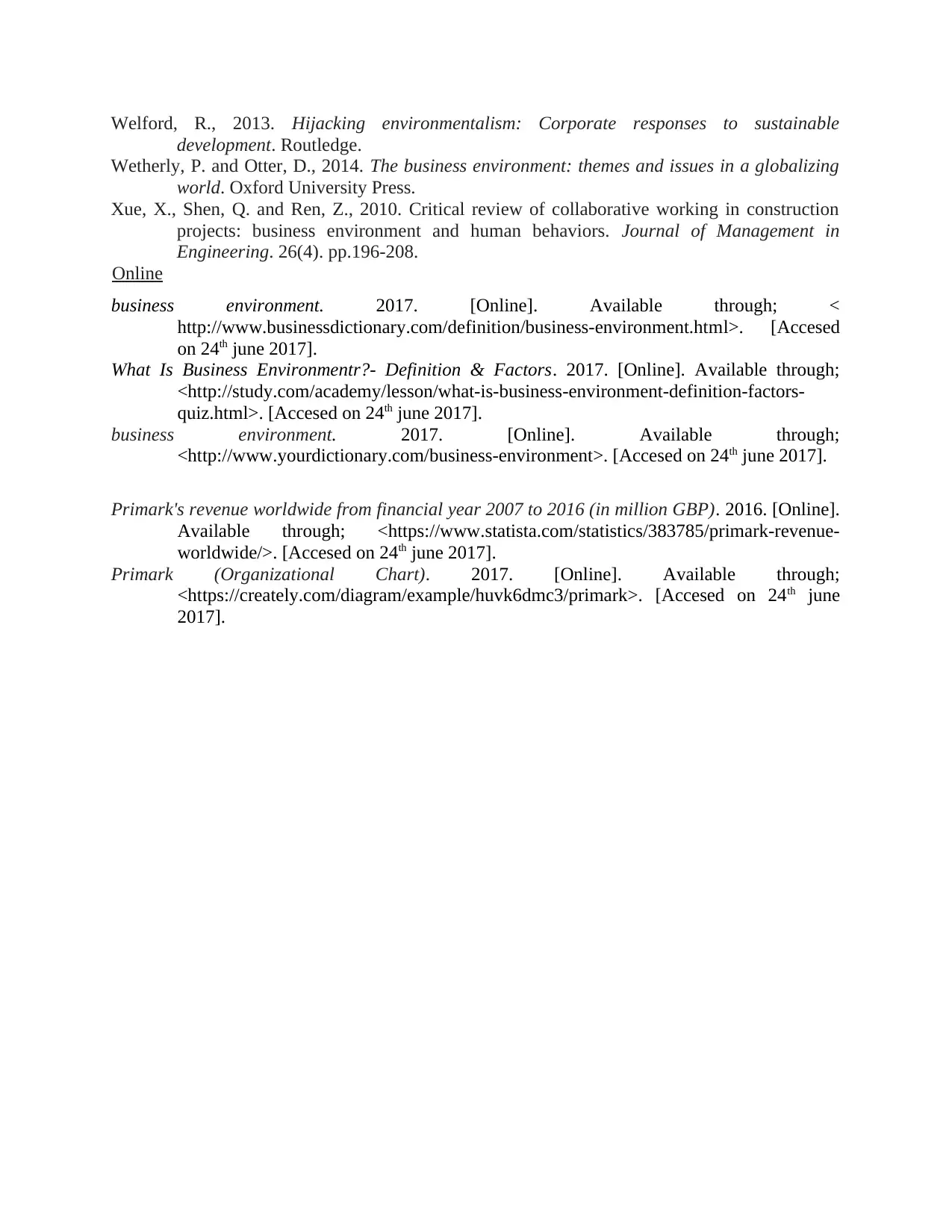
Welford, R., 2013. Hijacking environmentalism: Corporate responses to sustainable
development. Routledge.
Wetherly, P. and Otter, D., 2014. The business environment: themes and issues in a globalizing
world. Oxford University Press.
Xue, X., Shen, Q. and Ren, Z., 2010. Critical review of collaborative working in construction
projects: business environment and human behaviors. Journal of Management in
Engineering. 26(4). pp.196-208.
Online
business environment. 2017. [Online]. Available through; <
http://www.businessdictionary.com/definition/business-environment.html>. [Accesed
on 24th june 2017].
What Is Business Environmentr?- Definition & Factors. 2017. [Online]. Available through;
<http://study.com/academy/lesson/what-is-business-environment-definition-factors-
quiz.html>. [Accesed on 24th june 2017].
business environment. 2017. [Online]. Available through;
<http://www.yourdictionary.com/business-environment>. [Accesed on 24th june 2017].
Primark's revenue worldwide from financial year 2007 to 2016 (in million GBP). 2016. [Online].
Available through; <https://www.statista.com/statistics/383785/primark-revenue-
worldwide/>. [Accesed on 24th june 2017].
Primark (Organizational Chart). 2017. [Online]. Available through;
<https://creately.com/diagram/example/huvk6dmc3/primark>. [Accesed on 24th june
2017].
development. Routledge.
Wetherly, P. and Otter, D., 2014. The business environment: themes and issues in a globalizing
world. Oxford University Press.
Xue, X., Shen, Q. and Ren, Z., 2010. Critical review of collaborative working in construction
projects: business environment and human behaviors. Journal of Management in
Engineering. 26(4). pp.196-208.
Online
business environment. 2017. [Online]. Available through; <
http://www.businessdictionary.com/definition/business-environment.html>. [Accesed
on 24th june 2017].
What Is Business Environmentr?- Definition & Factors. 2017. [Online]. Available through;
<http://study.com/academy/lesson/what-is-business-environment-definition-factors-
quiz.html>. [Accesed on 24th june 2017].
business environment. 2017. [Online]. Available through;
<http://www.yourdictionary.com/business-environment>. [Accesed on 24th june 2017].
Primark's revenue worldwide from financial year 2007 to 2016 (in million GBP). 2016. [Online].
Available through; <https://www.statista.com/statistics/383785/primark-revenue-
worldwide/>. [Accesed on 24th june 2017].
Primark (Organizational Chart). 2017. [Online]. Available through;
<https://creately.com/diagram/example/huvk6dmc3/primark>. [Accesed on 24th june
2017].
1 out of 21
Related Documents
Your All-in-One AI-Powered Toolkit for Academic Success.
+13062052269
info@desklib.com
Available 24*7 on WhatsApp / Email
![[object Object]](/_next/static/media/star-bottom.7253800d.svg)
Unlock your academic potential
© 2024 | Zucol Services PVT LTD | All rights reserved.





